






Happy February, everyone.
During these past winter months, an amusing little phrase has come to my mind, which I hope you may find relatable. It often happens around January or February where I feel a particular kind of languor that can best be described by the phrase: “My bees are asleep.”
Basically: my “bees”—aka my “muse,” or my “creative drive”—have slowed down. The cold, dry air has me cooped up inside, reluctant to do anything but sink deep underneath my kotatsu, and as an artist who is constantly brimming with ideas for stories or art, this feeling is dreadful. It’s a boring, maddening feeling, like I should be doing something with my time, but I can’t seem to catch a spark of inspiration.
I try not to worry, for my “bees” are light sleepers. Over the past five years, I’ve come to learn and accept that winter in Japan really does have a profoundly “foggy” effect on me. I lose track of time, I forget things, and I just need a bit of time alone to lift myself out of that fog.
Soon enough, an idea inevitably comes to me, often completely out of the blue, and it is punctuated by the littlest, subtlest buzz. . .
If your “bees” are still asleep, then perhaps you can discover your spark of inspiration in our Art section’s featured article “Where to Find Art Supplies in Japan”. While you’re at it, go ahead and check out Entertainment’s “Journaling on JET” article, too! Whether you are a novice looking to pick up a new hobby or you’re just looking for more artistic avenues to explore, these articles are sure to get those “bees” buzzing!
Or perhaps wanderlust is more your speed? How about a whole road trip through Kyushu?! Head on down to our Travel section to follow one JET’s exciting journey on “The Road Less Travelled”, starting with Fukuoka, Saga, and Nagasaki—with more to come in the future! Winter is such a nice time to travel to warmer prefectures down south, especially if your days have been particularly cold and dreary.
Maybe you took a look at your JLPT test results and realized that you really need a boost in your Japanese language studies. Or, perhaps you’ve let your studies fall to the wayside because you have found yourself in the dreaded language learning “plateau.” Fear not! Our Language section has an article just for you: “The Intermediate Plateau: How to Go from Intermediate to Advanced Japanese”.
Finally, for those of you faced with the crushing reality that your time in Japan is drawing to an end: help yourself to our Careers section, which may provide some inspiration for “Finding an Open Door” in your professional life. Afterward, hopefully you aren’t feeling completely lost about what to do in the near future.
Thanks, as always, for your continued support of our magazine. Want to contribute ideas or stories of your own to help other people get those “bees” buzzing? Visit our contact page to get in touch, or email me at connect. editor@ajet.net.
Kindly,
 Head Editor of Magazine
Photo by Zosia Szopka | Unsplash.com
Head Editor of Magazine
Photo by Zosia Szopka | Unsplash.com
FEBRUARY MEET THE TEAM QUESTION:
How many times have you gotten lost in Tokyo Station?
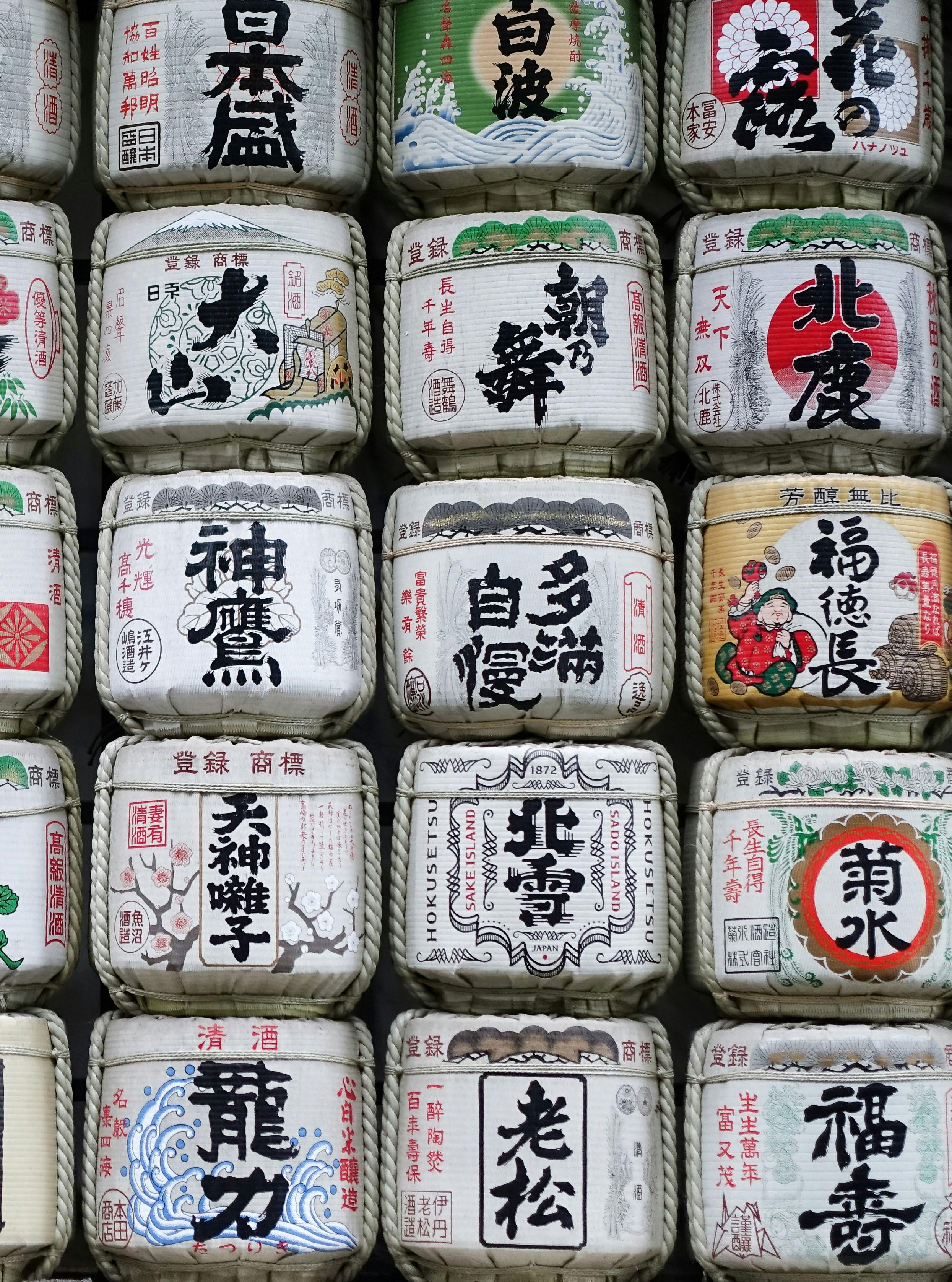
HEAD EDITOR
connect.ajet.editor@gmail.com
Dianne Yett
*Thousand-yard stare*
ASSISTANT HEAD EDITOR connect.ajet.assistantheadeditor@gmail.com
Sage Olges
I really thought I had finally figured out Tokyo Station’s layout, until I returned home from the winter break and found myself in a part of the station I never knew existed. I’ve gotten lost there far, far too many times to count.
HEAD DESIGNER connect.ajet.headdesigner@gmail.com
Kristen Camille Ton
Going to experience Tokyo for the first time this month. Wish me luck!
Sophia Maas
connect.generaleditor4@ajet.net
I’ve admittedly only been in Tokyo Station a few times, and yet it has seemed like every entrance I try takes me to a completely new place.
Becca Devoto connect.generaleditor5@ajet.net
My friend lost their shinkansen ticket in Tokyo Station. I tried to use my very, very poor Japanese to fix the issue. Only took several station employees to review footage and an hour of time.
Marco Cian
connect.ajet.webeditor1@gmail.com
Never. They have maps everywhere, and I have my phone with me.
Abigayle Goldstein
connect.ajet.webeditor2@gmail.com
I have never been lost in Tokyo Station— but I did get lost trying to get there from Yokohama. *tears*
ASSISTANT HEAD DESIGNER connect.ajet.assistantvm@gmail.com
David Spencer
Sorry, I blacked out for a moment there. What did you ask me?
GENERAL SECTION EDITORS
Ryon Morrin connect.generaleditor1@ajet.net
Pitta Gay-Powell connect.generaleditor2@ajet.net
Kianna Shore connect.generaleditor3@ajet.net
Veronica Nielsen connect.ajet.webeditor3@gmail.com
SOCIAL MEDIA
connect.socialmedia@ajet.net
Valerie Mercado
PR connect.ajet.prmanager@gmail.com
Jenny Chang
I think Tokyo Station is slightly easier to navigate than Shinjuku Station, where I wandered around aimlessly, in circles, for a good 20-30 minutes, trying to find my luggage in one of the thousands of coin lockers there.
HEAD EDITOR
Dianne Yett
ASSISTANT HEAD EDITOR
Sage Olges
SECTION EDITORS
Jessica Adler
Nabeela Basa
Thomas Coleman
Sierra Block Gorman
Kalista Pattison
Jon Solmundson
Holly Walder
Nomfundo Amanda Zondi
COPY EDITORS
Tori Bender
Sofia de Martin
Kaitlin Stanton
Zoë Vincent
GENERAL SECTION EDITORS
Becca Devoto
Pitta Gay-Powell
Sophia Maas
Ryon Morrin
Kianna Shore

HEAD OF DESIGN & LAYOUT
Kristen Camille Ton
ASSISTANT HEAD DESIGNER
David Spencer
ASSISTANT DESIGNERS
Aaron Klein
Li Chu Chong
Quinlan
WEB EDITORS
Marco Cian
Abigayle Goldstein
Veronica Nielsen
SOCIAL MEDIA
Valerie Mercado
PR
Jenny Chang
USJETAA
Kimberly Matsuno
COVER PHOTO
Reinis Birznieks
CONTRIBUTORS
Jessica Adler
Tori Bender
David Boling
Mark Christensen
Alexandra Cloete
Martina Comorkova
Christopher Dedrick R. Conwi
Justin Andrew Dobbs
Misha Husic
Erik Jacobs
Angelique Magistrello
Finlay McBride
Veronica Nielson
Hayley Wallace
Nomfundo Zondi
This magazine contains original photos used with permission, as well as free-use images. All included photos are property of the author unless otherwise specified. If you are the owner of an image featured in this publication believed to be used without permission, please contact the Head of Graphic Design and Layout, Kristen Camille Ton, at connect.ajet.headdesigner@gmail.com. This edition, and all past editions of AJET CONNECT, can be found online at http://ajet.net/ajet-connect/magazine-issues/ or on our website. Read CONNECT online and follow us on ISSUU.
Photo by Robin Ooode | Unsplash.com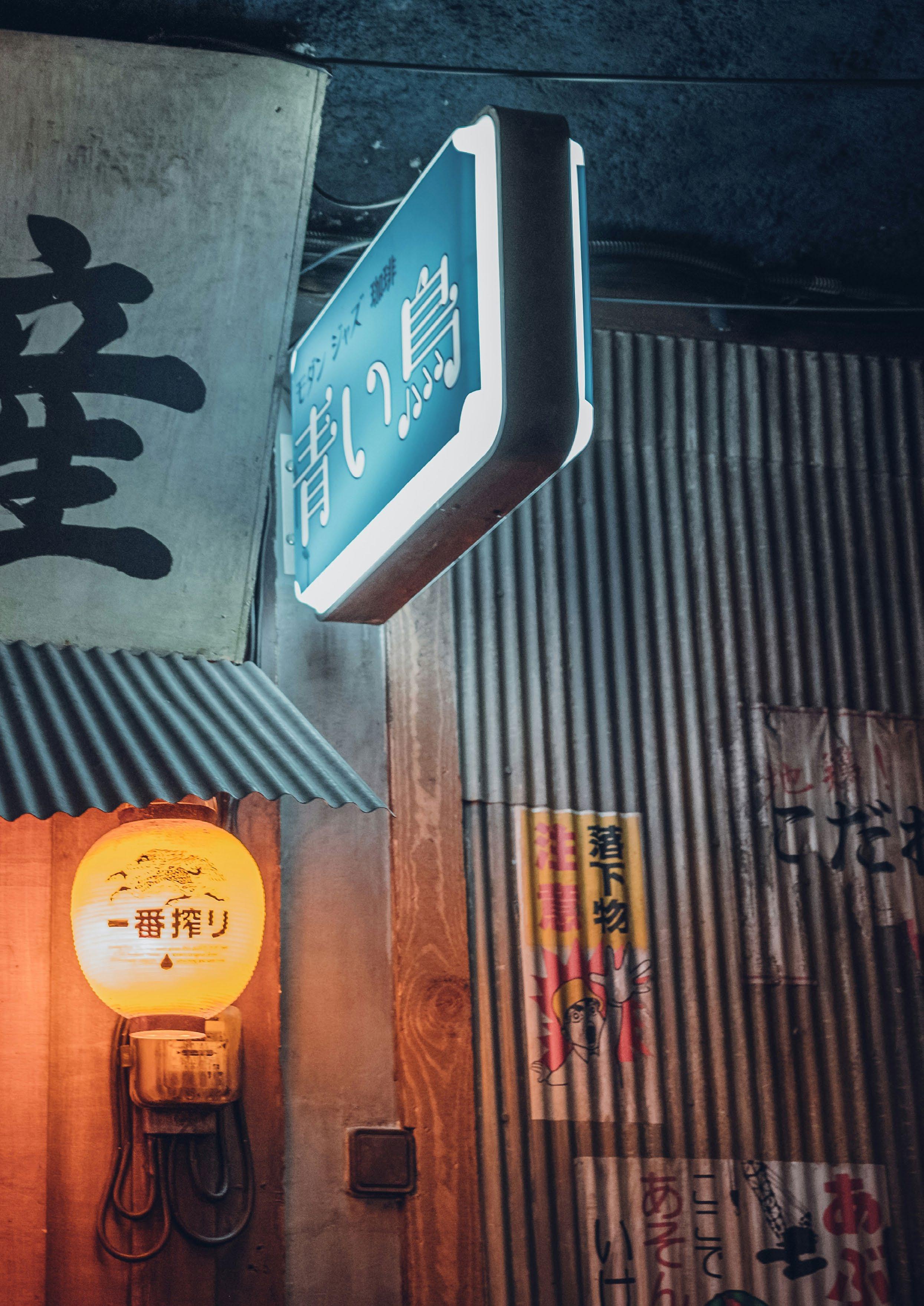
ARTS EDITOR
connect.ajet.arts@gmail.com
Sierra Block Gorman
Not all those who wander are lost. I’ve never gotten lost in Tokyo Station except on purpose. Sometimes you need to get a little lost to find something interesting.
ARTS DESIGNER
connect.ajet.headdesigner@gmail.com
Kristen Camille Ton
Going to experience Tokyo for the first time this month. Wish me luck!

ARTS COPY EDITOR
connect.ajet.copy4@gmail.com
Tori Bender
I’m not sure if I’ve ever been inside Tokyo Station. Take away ‘station,’ though, and I’ve been lost plenty of times!
CULTURE EDITOR
connect.ajet.culture@gmail.com
Thomas Coleman
Everytime I go! It feels like a time-honoured tradition at this point.
CULTURE DESIGNER
connect.ajet.assistantvm@gmail.com
David Spencer
Sorry, I blacked out for a moment there. What did you ask me?
CULTURE COPY EDITOR
connect.ajet.copy3@gmail.com
Kaitlin Stanton
After more than two years of living here, I’ve somehow never been to Tokyo Station. . .
Photo by Sora Sagano | Unsplash.com

no surprise that the country which gave the world Hokusai, Yayoi Kusama, and Studio Ghibli is a treasure trove for anyone interested in art. Whether you like ceramics, traditional painting, calligraphy, manga, or doodling on a notepad, you can certainly find a store that will have what you need to pursue your next artistic venture in Japan. This article will introduce some art supply stores around Japan, where they are located, and what kinds of materials you can find in them.
Tori Bender (Hyogo)
Tokyo alone has an endless supply of materials available. But fear not, those outside of Tokyo—there’s no need to travel across the country for high quality materials! It goes without saying that supplies used for more niche or traditional arts— kintsugi or figurines, for example— may be harder to find in your typical art store and may only be available in a specialty shop. For the sake of brevity, I have limited the list mostly to stores that carry a wide variety of products. After visiting several locations and doing some research, I’d like to introduce nine fantastic art supply stores across Japan.

Locations: Tokyo, Saitama, Nagoya
Specialty: Everything
Online Shop: Yes
Website
Founded in Tokyo in 1945, Sekaido is perhaps one of the biggest and most well-known art supply stores in Japan. With various stores across the Kanto and Tokai regions, their largest and most famous store is a five-story shop located right in Shinjuku. With five floors, Sekaido is a playground for any artist. You can find a huge variety of stationery, office supplies, comic-making supplies, design supplies, modeling materials, drawing supplies, and painting supplies of Japanese and Western varieties. It’s easy to spend hours amongst the rows and rows of pens, markers, paints, and other fine arts materials here. One unique product you can find here is Poster Color paints, the water-based paint often used by animation studios like Studio Ghibli. As the store originally sold painting frames and paintings, they also have a section of frames for sale. Even if you’re not located in Tokyo, Sekaido is definitely worth a visit on your next trip.

Locations: All
Specialty: Stationery
Online Shop: Yes
Website
Hands (formerly known as Tokyu Hands) is a store with locations all over the country. As it’s a department store, it has a less extensive selection of fine art supplies than other stores on this list. However, it still has a great amount of more common-use materials such as pens, markers, paper, and other stationery. Some locations do carry Copic alcohol marker sets and sketchbooks as well. Whether you’re into journaling, writing letters, or simply looking for a nice pen to use at work, Hands has something for everyone.
Locations: Hokkaido, Miyagi, Saitama, Ishikawa, Kanagawa, Gunma, Kyoto, Osaka, Hyogo Specialty: Everything
Online Shop: Yes Website
Arc Oasis—one of my personal favorites—is a hobby store with multiple locations across Japan. A branch of a large art company named Bunpodo, this particular store can be compared to Michaels or Hobby Lobby in the U.S. The store houses a multitude of fine arts—supplies similar to Sekaido’s selection, but on a smaller scale. They have several brands of paints from Japan and overseas, as well as calligraphy and comic-drawing supplies. What stands out to me is their large selections of frames, canvases, and brushes, so I personally stock up on these when I go. They also have other crafting supplies such as beads, wooden models, fabrics, and a variety of DIY materials. If you’re looking for anything crafty, Arc Oasis surely has it.

Locations: Tokyo, Kanagawa, Osaka
Specialty: Copic markers, everything
Online Shop: Yes Website
Tools is a shop located in Tokyo and Osaka. Interestingly, the shops are managed by the same company that created Copic markers, the alcoholbased markers which have taken off in recent years. While not a huge store, Tools still sells a good variety of high-quality fine art supplies such as paints, ink, sketchbooks, clay, and of course Copic markers. The Osaka location has a huge selection of the markers—practically an entire wall of colors you never knew existed. The Tokyo location, on the other hand, has a “Copic clinic,” where they can clean your markers or replace the ink and nib for a small fee. How convenient!

Locations: Fukuoka
Specialty: Painting supplies, frames
Online Shop: No Website
If you’re in Kyushu, Yamamoto Bumpodo is a great place to go for fine arts supplies. Open since 1932, this store is owned by the Bumpodo art company, which manages several art stores across Japan. It specializes in paints and framing, but also has an extensive selection of other fine arts supplies. There is a full list of everything available on their website, and they have a fantastic selection of both Japanese and overseas fine arts products, from calligraphy to sculpting materials. Additionally, the store has a gallery with rotating exhibitions from a variety of genres, so you can browse some local art after you shop. (カワチ)
Locations: Osaka
Specialty: Everything
Online Shop: Yes (limited supplies)
Website
Kawachi is an iconic art store founded in Osaka in 1920, with its main location in Shinsaibashi. This is another store with nearly no limit on the types of fine arts products it sells, and plenty of painting, drawing, and modeling materials. They have custom framing services available as well. This store is definitely a favorite amongst locals for buying traditional fine arts supplies, and I recommend going here for its sizable selection if you’re in the area.
Locations: Hokkaido, Miyagi, Tochigi, Tokyo, Saitama, Kanagawa, Chiba, Yamanashi, Shizuoka, Aichi, Mie, Kyoto, Osaka, Hyogo, Nara, Hiroshima, Fukuoka, Kumamoto
Specialty: Crafting
Online Shop: Yes
Website
Yuzawaya is a haven for crafters, knitters, and sewers. Here you can find things like fabrics, knitting materials, embroidery, sewing machines, and more. They also have a variety of clays available. Their website isn’t too difficult to navigate, and they have a seemingly endless supply of materials available to purchase online.

Locations: Tokyo
Specialty: Pigments
Online Shop: Yes
Website
While this one is exclusively located in Tokyo, the quality and aesthetic alone make it worth mentioning. Pigment Tokyo is a store specializing in high-quality pigments in Higashi-Shinagawa, Tokyo. Rather than coming premixed with oil, glue, or another binder as a paint, pigments are sold as advertised—a pigment. With around 4,500 pigments to choose from, the store also sells highquality paper, ink stones, and over 600 brush types. The store’s interior alone is a work of art, so definitely I recommend stopping by if you’re in the area, especially if you’re interested in sourcing your paints in a traditional, down-to-earth way.
Locations: Everywhere
Specialty: Basic art supplies, stationery
Online Shop: No Website
No art store list is complete without the obligatory Daiso mention. Heaven for stationery lovers, Daiso has occasionally surprised me with its occasional good stock of fine arts supplies. It varies from location to location, but you can often find basic sketchbooks, calligraphy materials, paints, and clays at this 100-yen shop. Keep in mind that some locations will have just the bare minimum as far as fine arts supplies go, but the things they do have usually get the job done.

If you haven’t been in Japan for long, finding arts and crafts supplies that you like can be one of the many challenges of settling in. It took me quite a while to figure out where to get certain things as I was more used to the super-sized crafting stores back in North America. Of course, there are other options besides these, such as online retailers and local businesses (and it’s also worth mentioning that you can usually find manga supplies at manga or book stores, like Animate). Regardless, I hope this list can be a resource and help guide you in your future artistic pursuits! is an ALT, artist, and copy editor for CONNECT based in Central Hyogo. She loves the countryside and anything cozy or nostalgic. You can find her on Instagram.

Restaurants, cafes, and similar establishments are some of the easiest and most common ways to experience and directly engage with countless cultures different from your own, whether you’re traveling abroad or just exploring new places in your hometown. This is, of course, true for Japan as well. While we may immediately think of sushi restaurants, ramen shops, and tea houses as representative of Japanese culture, within Japan itself, coffee shops have served an important role as cultural conduits over the past century or so.
From their inception, Japanese coffee shops were rooted in cultural exchange. The very first Japanese coffee shop opened in 1888— right in the middle of the Meiji era, a time of rapid Westernization in Japan. (1) The owner of this shop, Tei Eikei, was born in Nagasaki in 1859 and raised by Tei Einei, the Taiwanese Secretary of the Japanese Foreign Ministry at the time. Eikei’s upbringing was incredibly multicultural, and he learned to speak four languages in his youth: Japanese, Chinese, French, and English. In 1877, at the age of 16, he travelled to the United States to study at Yale. During his two-year stay abroad, Eikei developed a liking for coffee, and on his way back to Japan through Europe, he visited many well-known coffee shops in the United Kingdom. (1) (2) He was particularly drawn to London’s “penny universities,” a name that British coffee houses earned by dint of their reputation as places for disseminating news, discussing politics, and holding informal lessons on various topics. Guests could partake in these activities for the price of a coffee: a single penny. (3)

Eikei eventually opened his own coffee shop in Tokyo, called Kahiichakan (可否茶館). (1) (2)His time abroad meant that Kahiichakan was closer to the British coffee houses and gentlemen’s clubs he had experienced than to any standard Japanese food establishment. This was reflected in its decor and amenities, which included leather furniture, billiard tables, various smoking paraphernalia, and more, as well as in its clients, which were entirely men. Eikei described Kahiichakan as “a space to share knowledge, a social salon where ordinary people, students and youths could gather,” undoubtedly evoking the imagery of the penny universities he visited in Europe. (1) His shop closed after only five years of business, but during its run it certainly offered patrons a taste of life overseas. And much like their British counterparts, Kahiichakan and other early Japanese coffee shops quickly developed into local centres of information and cultural exchange.
As hubs of knowledge, these coffee shops, called kissaten (喫茶店), were essential resources for city life in the mid-to-late Meiji era. (4) During this time, along with rapid modernization, Japan saw a large influx of people moving from rural to urban areas, and kissaten became common meeting grounds for these newly-arrived residents. Aside from their Western-inspired aesthetics and menus, they served as spaces where new folks could gather to learn about the ways of city life from locals, forge new connections, and settle into their new communities. They were also spaces for people to meet with others from their home regions, speak their hometown dialects again, and share aspects of life from these areas with others. As people continued moving into cities from elsewhere, coffee shops gradually developed into trendy spots where patrons from all walks of life could be found.

By the end of the Meiji era, the Japanese image of a coffee shop was firmly that of a modern place, at a time when “modern” was still largely equated with “Western.” (1) (2) Coffee shops still leaned heavily into Western influence for everything from their design, atmosphere, food, tableware, and cutlery, even to the employee uniforms and customer-employee interactions. (5)Instead of going to a counter to order or using ticketing systems common at the time, customers were typically seated first and their orders were taken by the staff directly at their seat. (6) Western dishes and drinks were brought by waitresses to patrons in wood chairs and tables covered in crisp, white tablecloths, a sharp contrast to the traditional Japanese tea shop’s tatami floors, minimal furniture, and tea ceremony customs. Throughout this period, the clientele also shifted from predominantly male to all genders. Particularly common were the moga (modern girls; モダンガール) and mobo (modern boys; モダンボーイ), fashionable young people of the day known for their Westernised style and conduct. (2) Many of the coffee shops they frequented were located in Ginza, an area of Tokyo that to this day is associated with the Western upper class. (5)
While the coffee shops of the late 1800s and early 1900s took much of their Western influence from Europe, by the mid-1920s public taste had shifted more towards an American edge, bringing with it the sounds of jazz to Japanese cafés. (6) As intercontinental travel became more accessible, Japanese people who had been to the United States brought jazz records back with them to Japan. These records were often then played in cafes for other customers to enjoy. As the connection between coffee shops and jazz music grew, the jazz kissa (ジャズ喫茶) developed as a door to Western jazz and music culture. Musicians and music lovers came to these shops to discover new American jazz artists, listen to their favourite records, or simply enjoy the music because they couldn’t afford to have a personal record collection. (7) By the 1950s, going to jazz kissa was one of the most popular ways for Japanese people to listen to jazz. Today, Japan has one of the largest jazz communities in the world, undoubtedly due in part to these opportunities that jazz kissa provided for the Japanese public to connect with jazz and other music from different cultures.
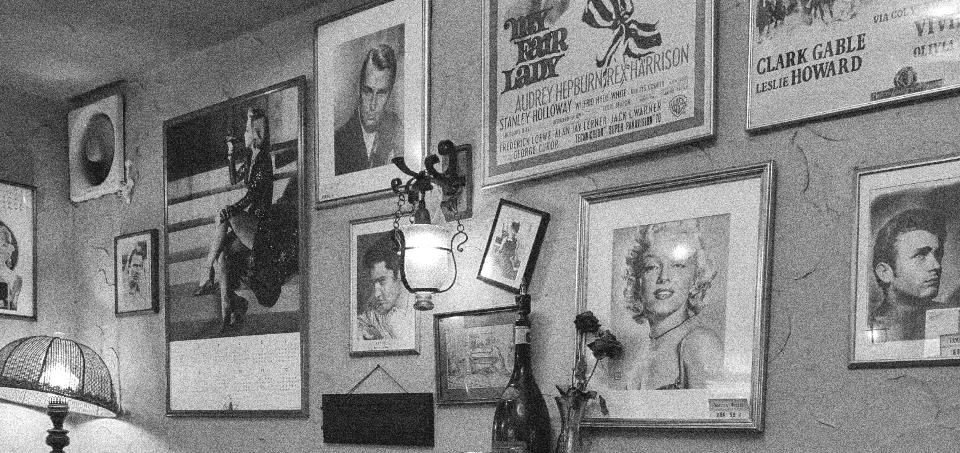
Much like jazz, which started as a Western import and eventually developed a unique Japanese variant, the quintessential Japanese kissaten would likewise develop over time. The kissaten of the late 20th century became a place for the everyday person to visit, either by themselves or in a small group of friends. The atmosphere was determined by the owner’s personality, and the relationship between the owner and the guests became an important part of the shop’s character. (2) While a Western influence can still be felt in Japan’s coffee scene (especially considering the popularity and number of Western coffee chains including Starbucks, Seattle’s Best, Tully’s, and others) many traditional coffee shops are still operating today, much in the same way as they were decades ago. The retro feel and long history of these classic shops has made them somewhat like a time capsule, preserving the Japanese coffee culture of days long gone. Since the 1980s, such shops have waned in popularity as modern chains and independent cafes have gained traction; however, the pendulum might be swinging back in their favour. (8) (9)
There has been an interesting phenomenon noted recently of the traditional kissaten seeing somewhat of a resurgence in Japan. (8)Young people especially have been going to these coffee houses for the unique, almost sentimental atmosphere that they have. Inside dark spaces with rich mahogany furniture and air often heavy with cigarette smoke, a small team of staff in black and white uniforms work behind long bar-like counters. They often brew darker roasts of coffee, as either a pour-over or using the rather beautiful and sometimes even mediaeval-looking syphon method. Their drinks are served in glasses or colourful china with floral patterns, and light meals such as toast or cakes are often available. All of these elements evoke the feeling of a time gone by, and what may have felt dated 20 or 30 years ago now holds a certain allure precisely because of the nostalgia that it carries. The recent spike in the popularity of such coffee shops speaks to a curiosity about the history and even the tradition of Japanese coffee houses from both locals and foreigners.


And so we come full circle. What was once a gateway for Japanese people to experience Western life has, over time, evolved into a way for Westerners to experience a part of Japanese life. Indeed, doing a quick Google search of the phrase “traditional kissaten” today will give you pages and pages of articles listing kissaten recommendations for tourists to visit and have a coffee experience that is classically Japanese. Although Western influence will likely remain an inextricable part of the Japanese coffee scene for the foreseeable future, the coffee shop itself as a place of cultural exchange has taken quite a turn, as it now serves as an exemplar of the Japanese way of living. So, whether you’re a coffee aficionado or someone who likes learning about Japan, next time you get a chance, head over to an old-school kissaten to get a sip of Japanese history unlike you’ve ever had before.
Misha is a third-year ALT based in Hyogo Prefecture. When they’re not in the classroom, they enjoy spending their time doing kyudo, visiting shrines and temples and, of course, going to all sorts of cafes near and far. Though a majority of their writing has been in the sciences, they do enjoy branching out every now and then, and have most recently launched a website where you can find more of their work.
Image credit: Misha Husic (Hyogo Prefecture)1.Merry White. 2012. Coffee Life in Japan. Berkeley. University of California Press.
2.Claire A. Williamson. 2017. A Coffee-Scented Space: Historical, Cultural, and Social Impacts of the Japanese Kissaten. Student work. Yale University.
3.Megan Macasaet. 2021. A Penny For Your Cuppa: How Coffeehouses Revolutionized Coffee Consumption in England’s Seventeenth and Eighteenth Centuries. Constellations 12 (2). Website
4.Anastasia Widyaningsih, Putri Kusumawardhani, Diana Zerlina. 2021. Coffee Culture and Urban Settings: Locating Third Place in the Digital Era. The Cases of About Life Coffee Brewers in Tokyo and Kopi Tuku in Jakarta. Proceedings of the ARTEPOLIS 8. Website
5.Helena Grishpun. 2012. Sipping Culture: Coffee and Public Space in Japan and in Israel. Conference Proceeding 2012 vol. 1. Israeli Association for Japanese Studies.
6.Elise K. Tipton. 2001. Rectifying Public Morals in Interwar Japan. Crime, Histoire & Sociétés / Crime, History & Societies, Vol. 5 (2).
7.Olga Kwaczyńska. 2020. The Reception of American Jazz in Japan: An Outline of Issues. Kwartalnik Młodych Muzykologów UJ.
8.Sabukaru. Japan’s Past and Present: An Introduction to Kissaten Culture. Jan 10th, 2024.
9.Tokyo Weekender. 2022. Millennials and Gen Z-ers Behind Japan’s Latest Kissaten Revival. Jan 10th, 2024.
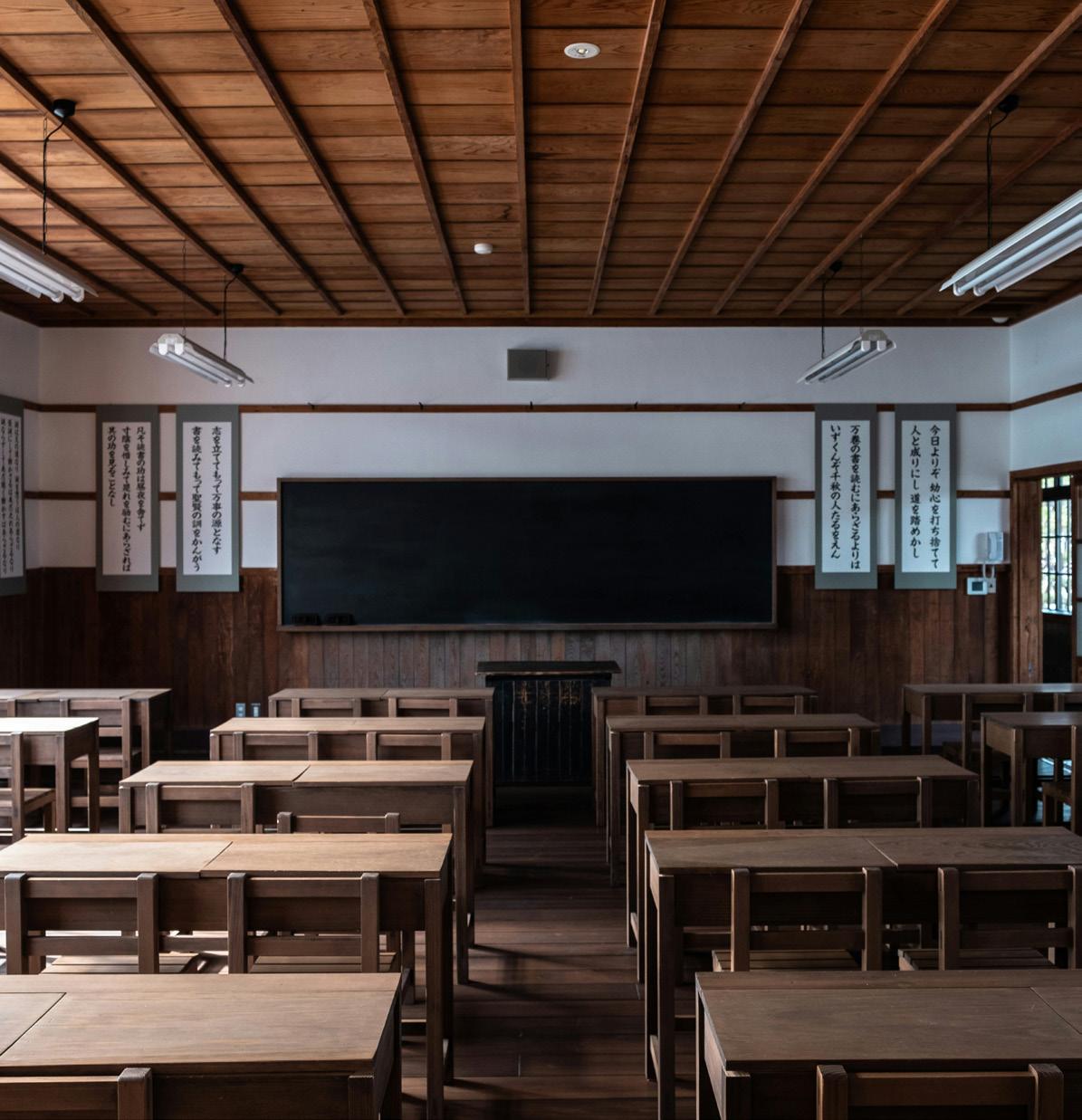
The students have been incredibly receptive, many of whom I’ve already formed a great relationship with. From the moment I arrive at school to the minute I leave, I’m met by swarms of frantic waves and beaming grins. Throughout the day, the students and I frequently trade jokes in the halls, enjoy a kickabout at lunch, and share laughs over my shaky Japanese.
When I’ve not been teaching, I’ve taken part in some of the many cultural activities that Japanese school life has to offer. I’ve rather heavy-handedly constructed an origami crane, stabbed my way through a calligraphy class, and finally showed some promise at sports day after I cruised past my 12-year-old opposition in the relay.
Being an educator is a tremendous privilege. There’s so much substance in shaping the lives of young people and great benefit in equipping them with a skill as functional as knowing a second language.
Teaching, however, has taught me more than I could have possibly imagined. It’s forced me to reconsider how I previously perceived education, to reflect on my own experiences at school, and to rethink my definition of a good learner
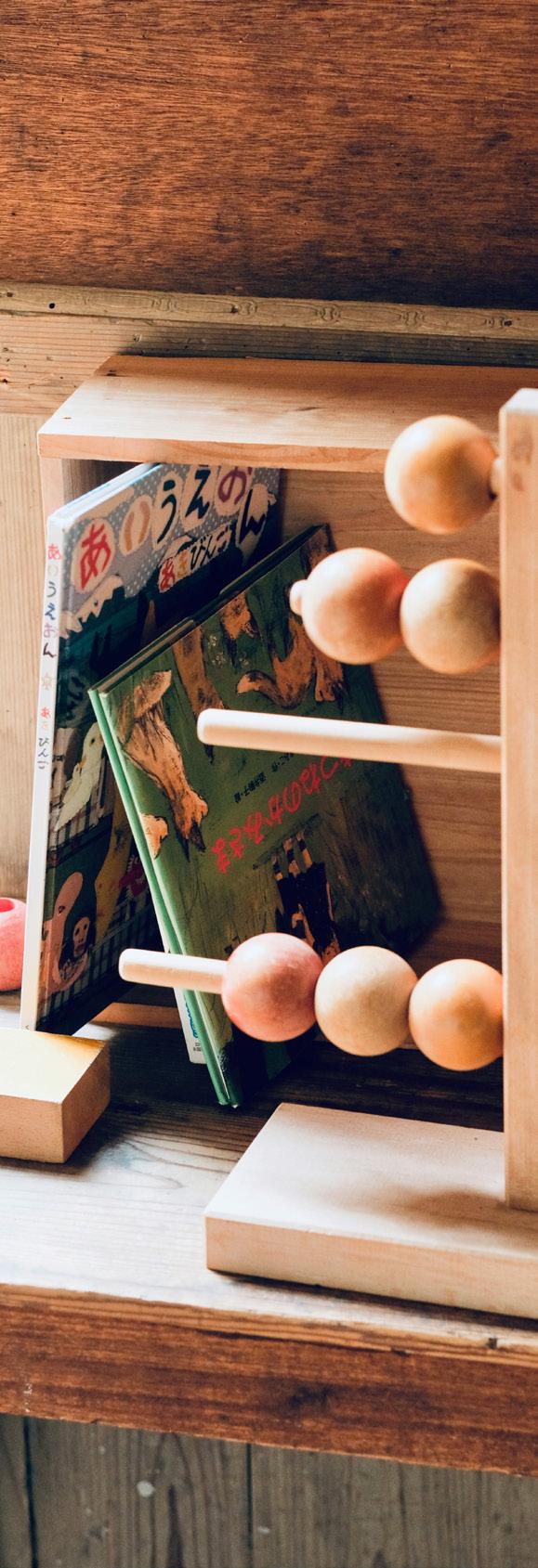

In youth, education is commonly undervalued and largely underappreciated. School can often be viewed as a place of anxiety, monotony, and, in some instances, tension. For many, this detracts from how wonderful school can be, and ultimately deprives those that disengage from the benefits that an education brings.
In my case, having spent only a short amount of time teaching, I now realise how helpful schools really are. The wide array of opportunities that they provide and the depth of resources that they offer.
It never occurred to me growing up that the place I was showing up to each day was designed specifically for my benefit. That every lesson planned, activity created, and worksheet printed were small contributions towards my success. Or that my indulgence in off-topic conversation and attraction to back-row gossip only came at my own disadvantage.
See, what I’ve come to understand is that schools are purposely devoted to the development of their students. It’s not something that I’m claiming as authentic or inconspicuous, but it’s a realisation that’s taken me until now to fully understand.
At school, I never quite grasped that what I was being taught was what I needed to know, or that how I was told to act was how I should have behaved. I always felt as though I knew better. That wasn’t because I was ignorant, but rather because I thought I knew my own needs better than anyone, especially a teacher. Looking back, I can concede that I was horribly wrong; that many of my teachers did in fact know better, yet for whatever reason I chose to pass up on their advice.
What I couldn’t see then but I can see now are the qualities that make a good learner. It doesn’t mean being the most intelligent or hard working, but being the most interested and invested. It’s achieved by seeing the purpose in what you’re learning and understanding the value of what’s being taught. A good learner is someone who possesses enthusiasm, who is both present and proactive, and who capitalises on the opportunities in front of them.
As the title of this article suggests, there’s a part of me that would go back and do it again—only this time differently.
With my newfound admiration for teachers and a greater appreciation of education, I would be less set on distractions and more intent on digesting the knowledge presented to me. I would challenge myself more, engage further in classroom debates, and have fewer concerns about making mistakes. I would take with me the idea that schools are investors and students are stocks. That with attention and focus my share price will grow and that displays of disinterest or disengagement will cause it to fall.
With that all said, I now pose this question to you. I’d like you to consider if at any moment you took your time at school for granted. Ask yourself whether your perception of education has changed, and if given the chance to go back, what would you do differently? I encourage you to reach out to your former teachers and thank them for their efforts. A small message of gratitude, even at this late stage, will mean a lot to them, I can assure you.
In life, learning never stops. It’s something we continuously get better at. And whilst we can’t change the past, we can improve moving forward. Building little by little, day by day.
Finlay is a first-year ALT based in Kagoshima City. Alongside a passion for writing he also enjoys uncovering Japan, spending time in nature and training in mixed martial arts.

SPORTS EDITOR connect.ajet.editor@gmail.com
Dianne Yett
*Thousand-yard stare*
SPORTS DESIGNER connect.ajet.assistantdesigner3@gmail.com
Aaron Klein
Aaron has never gotten lost in Tokyo Station, if only for the fact that he simply hasn’t managed to find his way there yet.
ENTERTAINMENT EDITOR connect.ajet.entertainment@gmail.com
Jessica Adler
Not many times, but that’s just because I hardly use that station whenever I visit Tokyo. Fun fact: I used to know the route from Ikebukuro Station to the Animate in Shinjuku! Can’t say I remember it anymore though. *laughs*
ENTERTAINMENT DESIGNER connect.ajet.assistantdesigner2@gmail.com
Quinlan
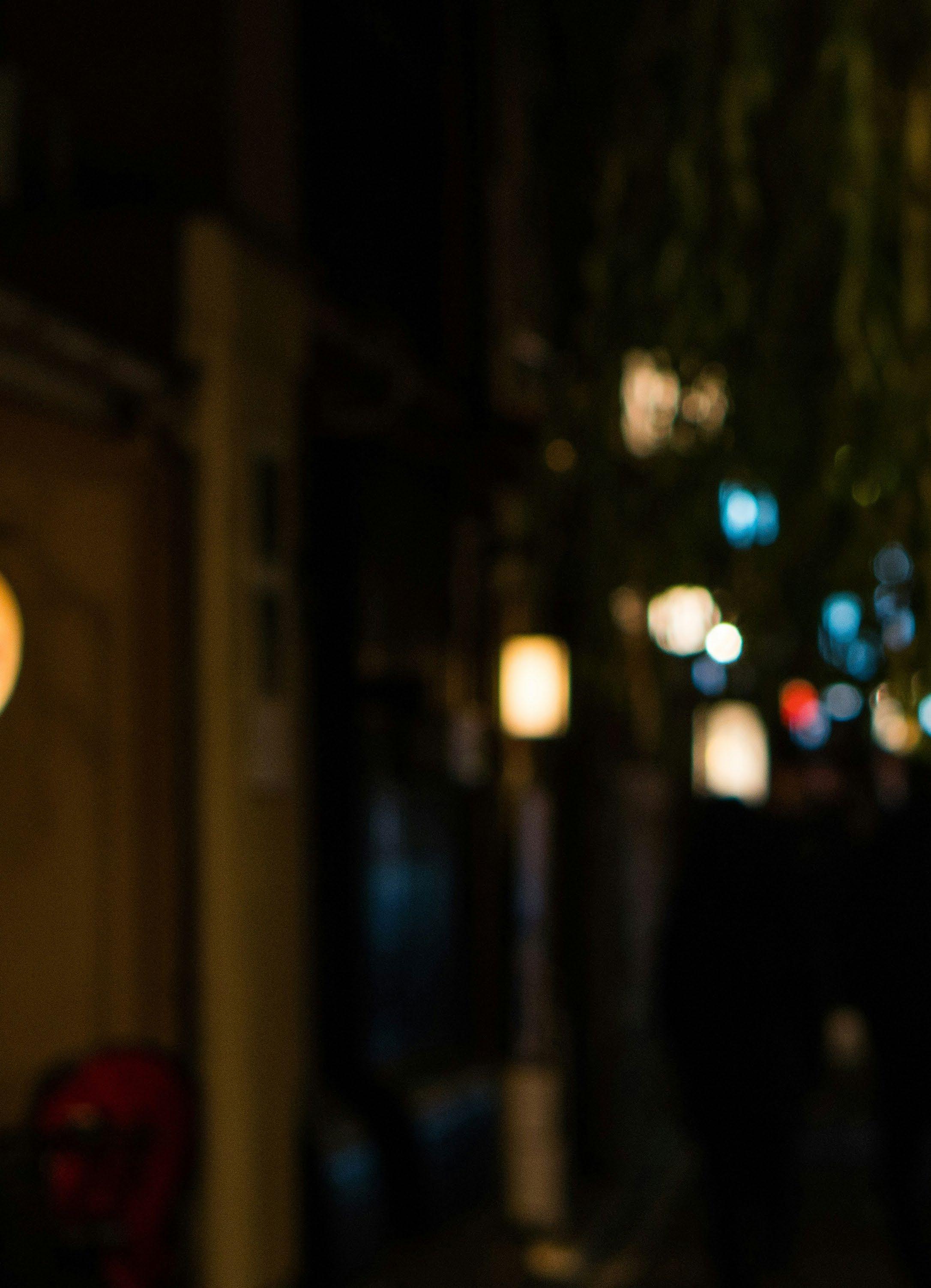
ENTERTAINMENT COPY EDITOR connect.ajet.copy3@gmail.com
Kaitlin Stanton
After more than two years of living here, I’ve somehow never been to Tokyo Station. . .
Photo by Elisha Terada | Unsplash.com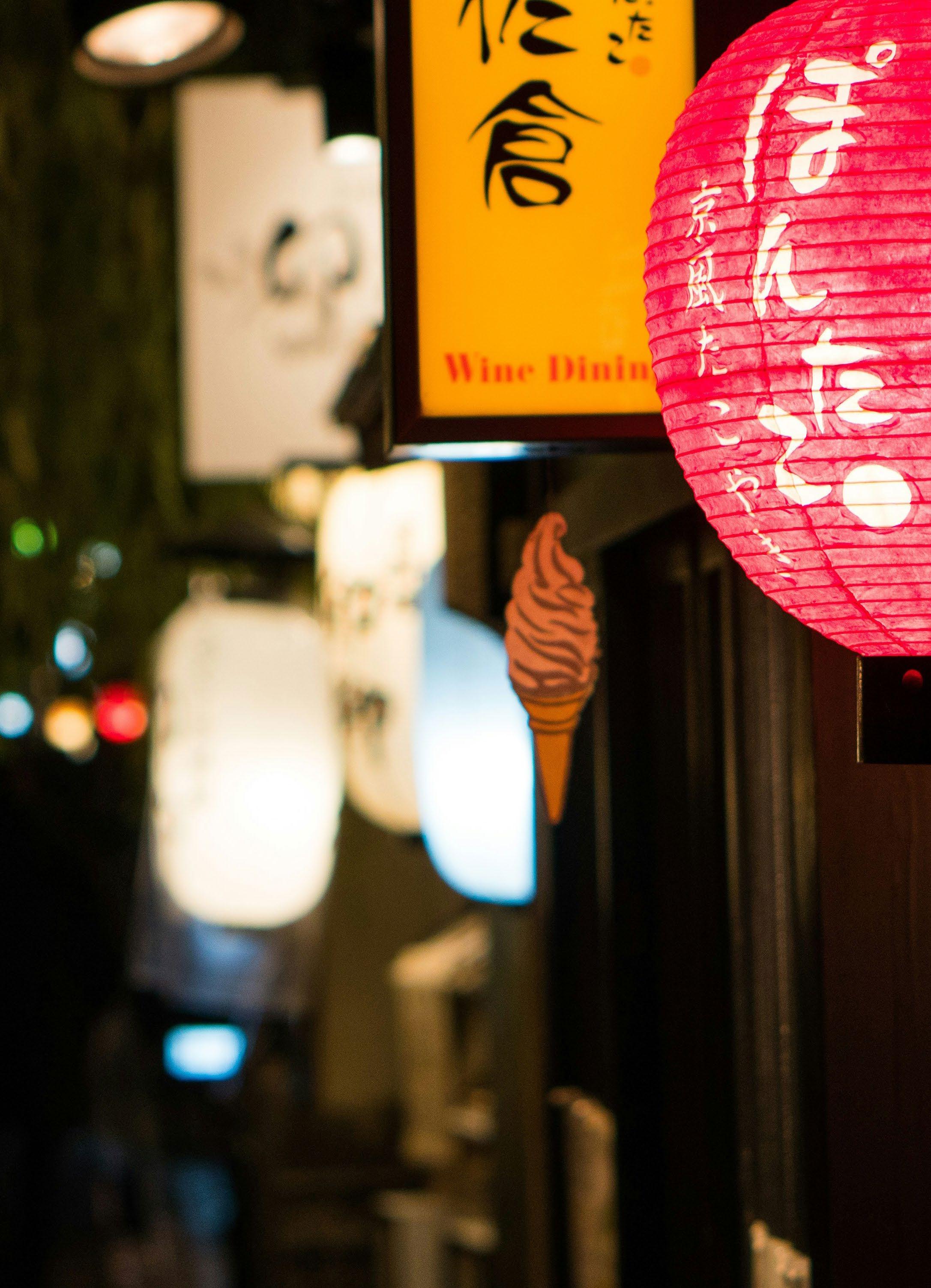



Known as a pop culture powerhouse in the world, it’s no secret that Japan delivers plenty of quality entertainment from anime, films, manga, and more. Lately, Japanese popular music has garnered more attention on the internet worldwide due to younger artists entering the Japanese music industry. YOASOBI, Fujii Kaze, and others are among those artists. But one who has achieved massive success before her 21st birthday this year is Ado, a Japanese solo artist who keeps her face hidden from the public and releases contemporary popular music. What do fans know about Ado, and why is she garnishing so much success at such a young age?

“She bought soundproofing material, set it up inside her closet, and recorded her music there.”
Born on October 24, 2002, Ado shared with her fans that her interest in music started when she gained inspiration from other anonymous singers, who covered famous songs without showing their faces on the popular video platform Niconico. Shortly after watching countless videos on the site via her Nintendo DS, Ado decided to try covering songs herself as an utaite, a singer who covers songs by other artists. These covers may often include songs from vocaloid, anime, video games, and other popular media posted on Niconico or YouTube. Given that Ado lived in a home with limited space, she bought soundproofing material, set it up inside her closet, and recorded her music there. After releasing multiple covers of songs by other Japanese artists, Ado quickly captured many viewers’ attention on Niconico.

Following this success, she recorded her first song, “Usseewa” (which would later go with her first studio album, “Kyogen, ” released in 2022) at age 17, which is an energetic song that resonates with many younger Japanese people and their frustrations they cannot easily vocalize toward the stressful shakaijin (society member) culture of Japan. The song has a distinctive composition, as Ado sings in a soft and innocent voice in one verse but quickly switches to an apathetic or growling tone in the next. Ado’s willingness to take a risk in voicing her criticisms toward this component of Japanese culture worked in her favor, as the song proved a massive hit among Japanese listeners.
After receiving mainly positive reception with her first album, Ado also revealed that she sang the vocal songs featured in One Piece Film: Red, which helped the movie obtain one of the largest opening sales weekends in Japanese cinema history. Performing the musical vocals for Uta, a main character in the film, Ado demonstrates her ability to earn an opportunity to provide music for a popular anime/manga series like One Piece, which is impressive for her age and relatively young musical career. While Ado has plenty more room for experimentation with her music and growth, her music and persona as an artist will likely continue to give Japanese popular music a more positive image among Japanese and

Photocred: Unsplash/Aditya Chinchure
international fans. With similar artists like Yama who remain anonymous and gain many fans through their music, Ado has demonstrated through her album, concert ticket sales, and her significant voice acting role for One Piece Film: Red that musicians in Japan can simultaneously produce and release music and enjoy anonymity to preserve their privacy from the public.
Although anonymous artists like Ado and others have inspired newer singers to conceal their identities from the Japanese public, whether her decision to do this will influence a similar trend outside of Japan will be interesting to observe. Except for singers like Sia (who
eventually revealed her identity before the public), many Western performers who don’t reveal themselves to others have not gained fame among fans as they have in Japan. As an American myself, I argue part of the reason the trend of anonymous singers has not caught on in much of the West is due to many fans’ burning interests in knowing the physical appearance of performers they admire. This is arguably true for many Korean pop fans who support solo artists or idol groups too. Given that Ado has stated on her All Night Nippon radio talk show that she wants to perform in America’s Coachella music festival one day, she may have potential to enjoy her anonymity as she extends her reach and builds her fanbase in the West. Nonetheless, if any newer Japanese artist can accomplish this endeavor, Ado is likely the only reputable singer who could do this.
Given her tremendous growth as a professional singer, Ado earned an excellent reception to secure an opportunity to perform at the Japan National Stadium next April. She will be the first female solo artist to sing music in the venue’s history, which is an honor. Shortly before, Ado will also embark on her first world tour titled “Wish,” spanning from February through April. With back-to-back concert performances, I look forward to watching how well Ado is received outside of Japan, specifically in countries like
the United States and France, where Japanese music is gradually gaining more popularity. Although she has announced she will primarily travel around the United States, Western Europe, and Southeast Asia for the tour, Ado may garner more success than many fellow Japanese artists who perform abroad as she introduces international fans to her hit songs like “Usseewa” and “Show,” which vastly differ from many Japanese pop songs that typically exclusively top music charts in Japan. After decades of the Japanese music industry pumping out idol groups who share similarsounding content, it has become increasingly evident among online communities that formulaic pop songs have grown stale among Japanese music fans in and outside of Japan. If Ado continues to explore a variety of musical genres, moods, and vocal styles, she will likely gain considerable recognition abroad in countries like the United States, France, and more. Ado has strong potential for standing among some of the first Japanese solo artists to achieve popularity there since Kyu Sakamoto’s “Ue wo Muite Aruko” dominated the US Billboard Hot 100 in 1963. Although her career is young, Ado’s ability to attract fans while performing songs inspired by different genres and her showcasing the same vocal techniques like growling that made her famous to begin with has given her a steady platform that will
likely continue to elevate her career at a more rapid pace than many other Japanese popular performers have achieved.
Veronica Nielsen is a second-year Coordinator for International Relations (CIR) on the JET Programme in Hiroshima Prefecture. She has been to over half of Japan’s 47 prefectures and has made her way to visiting Shikoku for the first time this year. She aims to travel to Kyushu, the last main island she has yet to see, soon.

“Ado has strong potential for standing among some of the first Japanese solo artists to achieve popularity there since Kyu Sakamoto’s “Ue wo Muite Aruko” dominated the US Billboard Hot 100 in 1963.”
“I personally found the stationery stores delightful: with their endless selection of pens...”

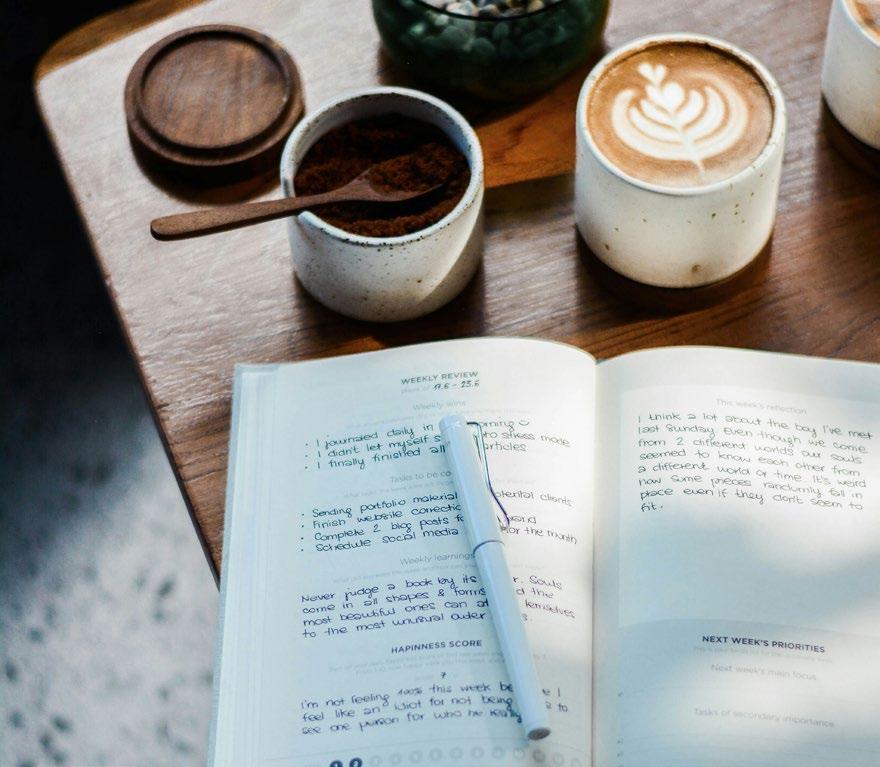
Japan’s world of stationery is a treat to any and all interested in giving letter writing, scrapbooking, or anything else handwritten a try. I personally found the stationery stores delightful: with their endless selection of pens, to innovative materials that could be used in a journal just for decorative purposes—they have it all! And so, I implore you to consider journaling as a meaningful and creative way to record your time in Japan. I know journaling can sound like a chore, so without further ado, let me introduce you to the wonderfully rich and vibrant world that is Japanese stationery!
My journaling obsession began like this: I noticed my friend using a really cutely designed notebook and made an innocent compliment to her about it. As if waiting for the chance to share, my friend gave me the name of the journal brand and praised its customization options and styles. Out of curiosity, I searched “Hobonichi Techo” and found my way to the store’s website, which was very user friendly and completely accessible in English. I was pleasantly surprised to find that Hobonichi Techo has a following worldwide, with the English-speaking community singing its praises alongside its dedicated Japanese following.
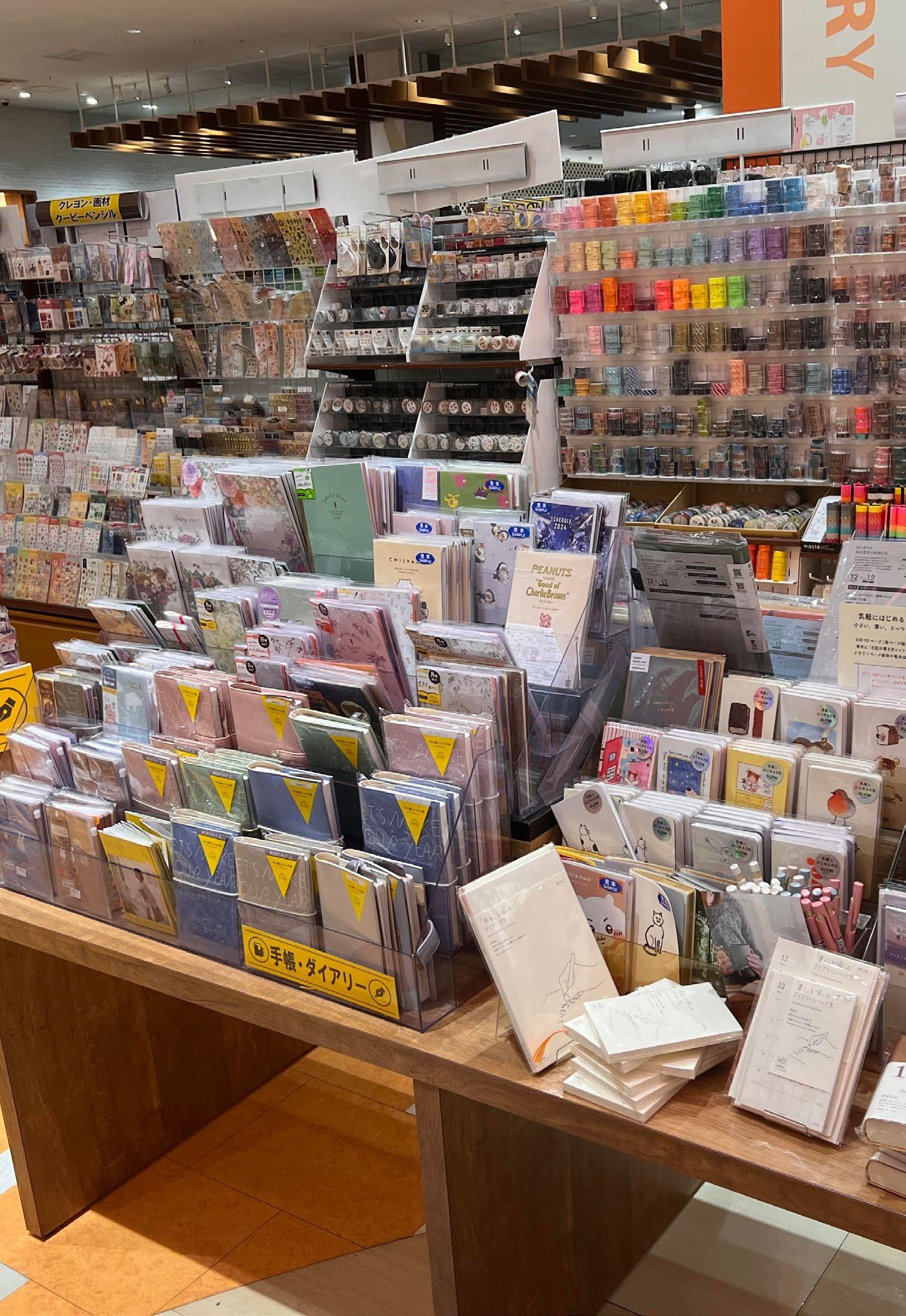
After falling in love with a certain Hobonichi Techo journal, I decided that I wanted to try writing down my time on JET. I wanted to challenge myself to complete a journal, something I had never been able to do in my life by this point. Curious to find inspiring ways to journal (the themes are endless: diaries, planners, positivity journals, notes, etc.), I stumbled upon a YouTuber named Rainbowholic whose focus is cute journaling or "kawaii" journaling. Her videos are so aesthetically pleasing that I was hooked on the thought of creating something similar Thus, my descent into gathering Japanese stationery began!
Japan has a thriving journaling and stationery culture. A prime example is the globally loved brand Hobonichi Techo: every year, the founder, Shigesato Itoi, thinks of a slogan relating to the action of physically writing in a notebook. 2024’s theme is: “As long as you write, LIFE is PRESENT” He goes on to discuss his thought process as he switches from Japanese to English in order to reach out to the company’s international audience. As a part of that audience, I appreciate the thought put behind each yearly theme, and if you want to read more about it, the in-depth article can be found here. Personally, I think this slogan is encouraging, and gives food for thought. For instance, I know I am not alone in my dependency on my phone, but there is an inevitable draw (haha) to writing down one’s thoughts with a pen, and Japanese stationery certainly enables it.
You can find notebooks and journals of all kinds almost anywhere: a 100-yen store, a convenience store, and any chain bookstore such as Tsutaya. Most often, the items found in a stationery store are from popular brand names such as Hobonichi Techo, Traveler’s Factory, and Midori, but due to their popularity and high quality, the prices can add up quickly. I personally love being able to look through the samples provided and get a feel of the size and shape in person, but there are many ways to check them out online as well. You might make your mind up the moment you hold it, or be inspired by the countless influences on YouTube and other social media platforms. It’s easy to fall into temptation when you see a themed notebook too, trust me (and no, I don’t regret splurging on that Moomin comic diary!). However, if you just want to try out the journaling experience, then I recommend browsing your closest
100-yen shop. I recommend checking out Daiso, which has an impressively sized section dedicated to customizing your own planner for a wide range of purposes. They even have topic-specific notebooks like food diaries or travel journals, which already give you a prompt to write about!
“You can find notebooks and journals of all kinds almost anywhere: a 100-yen store, a convenience store, and any chain bookstore such as Tsutaya.”
It’s almost dizzying how many options and styles you could decide to decorate your journal with—they even have a special fair just for stationery! Dying of curiosity, I ended up buying tickets for 2022’s Bungu Joshi Haku, and to put it simply, it was amazing. I had the wonderful opportunity to meet one of my journaling inspirations and was even able to sign up and participate in a workshop of theirs.
It was an eye-opening experience
with massive crowds and a wide range of stationery goods, and I sure shopped! Japan knows how to showcase their stationery—with beautiful displays and tasteful combinations of suggested arrangements, it’s hard to resist trying them out. In addition to the main Bungu Joshi Haku that happens every year in Tokyo, I highly recommend trying to go to one of Bungu Joshi’s countrywide events (they happen all across Japan) that occur year-round. You can find more information regarding ongoing and upcoming stationery fairs here!

When I first got accepted onto JET, I had made a small promise with myself to try journaling my experience while working in Japan. Despite the whirlwind that is moving your whole life to another country, I can say with confidence that I successfully completed my journal from Hobonichi Techo for 2019. I was motivated to pen down my memorable experiences in a “positivity journal” style. And as I began to gather beautiful pens, washi tape, stickers, and the like, I became even more eager to journal. This kept up consistently until about 2022, when the free time I would normally set aside for journaling became more full with various outings due to COVID-19 restrictions being officially lifted. Unfortunately, my time for journaling became few and far in between as life resumed a pre-COVID routine.
However, as I look back through my earlier journals, they truly feel like a time capsule where I can retrace my memories and feelings of the past. Every so often I will dig out a journal to find an entry from years ago in order to recall a past event. With each passage I read through, it makes me appreciate the effort that went into each entry. Now
I have the perfect keepsake of my time in Japan!
What’s nice is that journaling is very flexible, and there are many ways to prompt yourself if you don’t feel like writing about your day. For example, I sometimes check out Rainbowholic’s monthly journaling prompts when I feel like being a little ambitious with my writing (and decorating).
For example:

Here is my resolution for 2024, and I would love to encourage others to join me in this challenge: to write almost daily in any form or capacity. Journaling has been an incredibly effective way to unwind and relax when I was consistently writing and reflecting on my daily life, so I really want to bring back the habit of daily journaling. Here are some topics to consider:
a favorite game, a single reflective thought about the day, or even a Japanese study notebook. I finally collected my selection of planners and diaries to attempt the challenge: one weekly planner, one comic-style diary (Moomin themed), one larger yearlong journal (from Hobonichi Techo), and. . . you get the picture.

Photocred: Unsplash\Prophsee

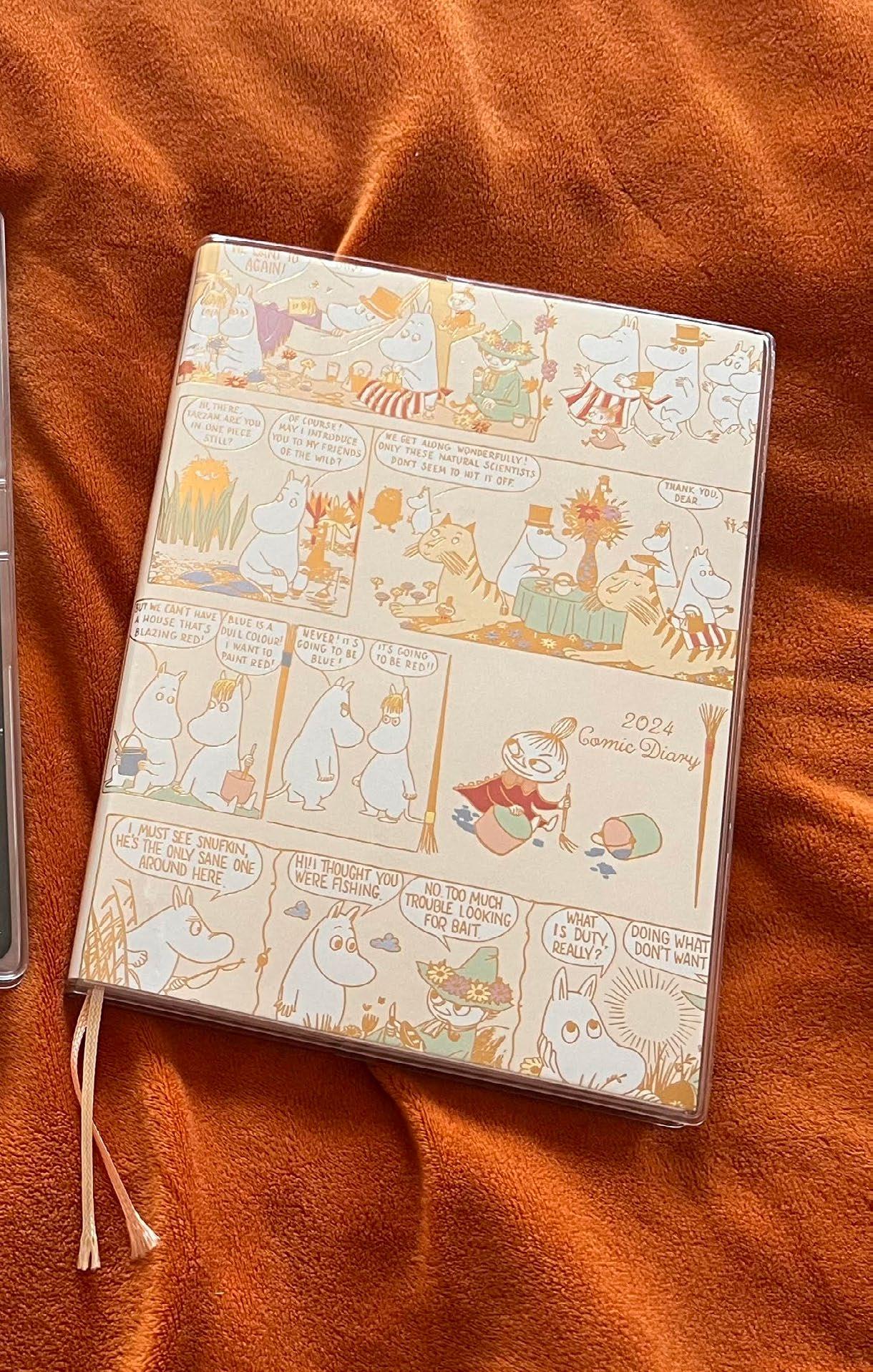
Browsing through the plethora of choices is easy, but purchasing said journal might not be. There are plenty of styles to choose from, but I would try not to get too caught up in the options. Easier said than done, I assure you, as Japan really has the right idea with LOFT and other stationery stores offering an abundance of themed planners, notebooks, and journals galore.
“Here are some topics to consider: a favorite game, a single reflective thought about the day, or even a Japanese study notebook.”
Here are some tips that I have personally found helpful formaintaining journaling motivation!
1 Choose a journal you find eye-catching! The more interest you have, the more likely you will pick it up, and the more likely you will try to write in it!
2 Start with one journal. You can always challenge yourself and add more as the year progresses! Too many places to write can become a chore and discourage you.
3 Keep your journal in eyesight; for, as they say, out of sight, out of mind.
4 Try a sentence a day, be it a check list or a highlight/thought about the day, and don’t beat yourself up for missing a few entries every once in a while. It’s very rewarding to see your past writing.
5 I wholly recommend including tickets and pictures. Japan also has a thing for stamps, which makes it fun to collect and add them to your journal!
There’s no pressure to write something for each day! I usually reflect about my week during the weekend or when I get the urge to write. But it’s also good to keep in mind that the habit will strengthen with consistency!
And with that, I wish you happy journaling!

Jessica is a fifth-year JET and the current Entertainment editor of CONNECT Magazine. She enjoys creatively journaling about her travels across Japan, and finding inspiration throughout her daily life. Her favorite journal brand is Hobonichi Techo. Lately she has found listening to a playlist helpful for productive journaling.

FASHION EDITOR
connect.ajet.fashion@gmail.com
Holly Walder
I thought I had Tokyo’s stations figured out before the pandemic, but the next time I visited Tokyo, everything had changed! Now I know to leave a good half an hour to get lost before reaching my destination.
FASHION DESIGNER
connect.ajet.headdesigner@gmail.com
Kristen Camille Ton
Going to experience Tokyo for the first time this month. Wish me luck!
WELLNESS EDITOR connect.ajet.health@gmail.com
Nomfundo Amanda Zondi
I have a one to one ratio of getting lost at Tokyo station to visits in Tokyo. I have been to Tokyo four times. I hope that makes it clear.

FASHION COPY EDITOR
connect.ajet.copy4@gmail.com
Tori Bender
I’m not sure if I’ve ever been inside Tokyo Station. Take away ‘station,’ though, and I’ve been lost plenty of times!
WELLNESS DESIGNER
connect.ajet.assistantdesigner1@gmail.com
Li Chu Chong
WELLNESS COPY EDITOR
connect.ajet.copy2@gmail.com
Sofia de Martin
I’ve gotten lost in Tokyo Station a respectable three times. How many times have I been to Tokyo Station? That’s a secret I won’t tell!
Photo by Jelleke Vanooteghem | Unsplash.com


osplay. In just a few decades, what once was a very niche hobby has become wildly popular with fandom communities, conventions, models, and even celebrities across a wide spectrum of interests.
But what is cosplay, really? Cosplay, or costume play, is the art of creating costumes and bringing characters and entities to life. This includes a broad range of subjects, from historical figures grounded in reality to the most fantastic fictional characters, entities, and monsters. And while it can be a daunting hobby to jump into, the truth is that it’s a field open to everyone and to all ages; your only true limits are your creativity, as humorously shown by creators like Lowcostcosplay.

y own journey with cosplay began 15 years ago. While I initially started using a premade costume, I quickly grew fascinated with the complex creations of other people around me and dreamed of reaching similar levels. While I lacked technical skills like sewing or crafting, I began to learn from, and work with, people who did know.
By the time I came to Japan, I was working with the 501st Legion, a professional Star Wars cosplay group. But there are levels of cosplay that reach truly dizzying heights. Of these, the World Cosplay Summit is the zenith.
Discovering the World Cosplay Summit was a happy coincidence. When I first came to Japan in 2019, I had naturally wanted to observe some events, but the COVID-19 pandemic shut everything down for several years. More recently, I started to look for opportunities, and when a cosplayer I follow mentioned previously competing in it, I put it on my list to research.
Looking into it, I discovered that unlike many conventions, World Cosplay Summit (WCS) is focused specifically on cosplay itself and that it seeks to determine the best cosplayer teams in the world. It does so by competitively ranking national teams from an ever-increasing number of participants. This year alone, 33 different countries participated.
With such a great opportunity right in the middle of my summer break and in a major city on my visit list, how could I resist? A short time later, I found myself on a plane for Nagoya.
I had many expectations going to WCS on day one, but I was fairly surprised by the setup.
While most conventions are typically held in enclosed spaces and centers with cosplayers meeting in adjacent parks, WCS was largely held outside in the Oasis 21 facility next to Nagoya’s Mirai Tower. The event itself was held in an oval patio and central stage, while overhead the giant glass canopy and the pool above it bathed the grounds in shimmering light. On the outer edges of the facility, several layers of balconies and stairs allowed visitors to look over and watch the events unfolding below. On the bottom level, various tunnels led to a series of underground stores supporting the venue.
Starting in the late afternoon, those of us lucky enough to snag seats filed into the seating in front of the stage. Overhead, crowds of visitors leaned over the railings and watched the projectors, while a live band prepared in front of the stage. And then, before we knew it, the red carpet event began.
With triumphant fanfare, pairs of cosplayer teams descended from the main event hall, dressed as favorite characters from popular anime and video games.
One featured pair was Ruby and Aqua from this year’s hit series Oshi No Ko; as they descended, Yoasobi’s “Idol” blasted from the orchestra.
Another pair of cosplayers presented themselves as Loid and Yor, the Spy/ Assassin couple from Spy xFamily.
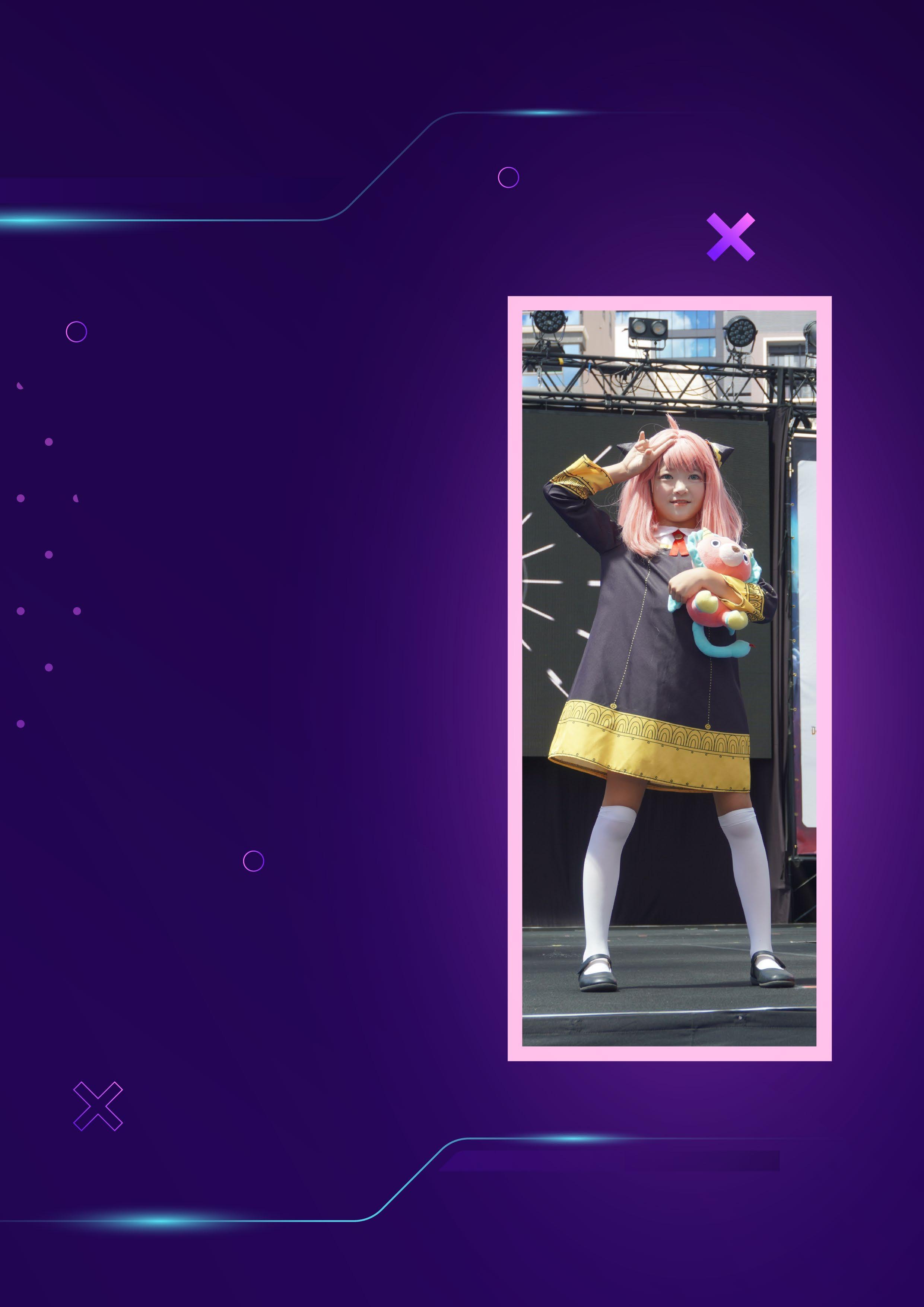
Some of the participants reached remarkable levels of accuracy. When Leon Kennedy and Ada Wong from Resident Evil 4 appeared, I did my first double take. They somehow managed to replicate not only the costumes and behavior of the characters, but also the subtle uncanny valley of CGI, likely through makeup.
Interestingly, some of the cosplays included more obscure characters, such as side villains. In total, about 66 cosplayers descended and assembled on the main stage. After some speeches by the city mayor and other officials (who cosplayed as Inuyasha and Slam Dunk players) the crowds and cosplayers dispersed, with many people setting up night photo sessions around the convention grounds.
Unlike the red carpet event, many of these cosplayers were members of the general public and brought their own projects to show off; some of them were very high quality.
One that caught my eye was a rare rendition of Naruto’s Hinata Uzumaki in her movieexclusive black wedding gown. While many cosplayers choose the most popular or hip cosplays, it’s always fun to see more obscure characters and costumes brought to life.
hile photographing Lucy from Cyberpunk: Edgerunners, I began talking to the photographers around her. I discovered that she and the photographers were actually a group of friends from Singapore and Malaysia. I connected with the group, and gained some insight into contemporary cosplay in Asia.
One of the photographers, a streamer known as AGCTV81, revealed to me that

many photographers and cosplayers regularly travel across Asia to various events; apparently in places like Singapore, cosplay is so popular there are reportedly weekly events. His job, I discovered, was providing live streaming and photography to a ready audience of viewers.
After parting with my new friends, I returned to my hotel, wondering what the next day would bring.
ay Two of the convention had a lot of variety. Throughout the day, the central stage rotated various cosplay and idol groups apart from the main contestants. There was a surprising variety in age, too. In one instance, a small girl who couldn’t have been more than eight years old cosplayed Anya from Spy xFamily and performed a dance with some older cosplayers from the same series. In another case, a man suspended in a massive Gundam cosplay clanked perilously around the edges of the stage. Others held mock battles and skits.
Throughout the day, there were various other competitions and photoshoots at the venue. But everything else paled in comparison to what came next.
In the late afternoon, the main theater hall opened up, and crowds of viewers piled in to watch the main event: The WCS Championship.
The tournament itself was broken up into multiple team blocks that were being judged not only for the quality of their cosplay designs, but also for their theatrical acting skills. With less than five minutes per team, participants had to do two person skits. And this is where things got remarkable.

As it turns out, the teams had gone well beyond costumes and prepared their own music tracks, special effects, props, and acrobatics. So what might have been adlibbing for regular cosplayers turned into highly choreographed action and emotion that captivated the audience.
In one instance, Naruto’s Kakashi battled the rogue ninja Zabuza. Their fight had Kakashi and Zabuza compete with gymnastic leaps, flips, and dodges, before culminating in Kakashi’s famous copy technique. With a finisher, Kakashi drove his hand into Zabuza’s chest and, incredibly, pulled out his heart in an explosion of confetti gore.
In another instance, Final Fantasy VII’s Cloud Strife fought against the infamous villain Sephiroth. The villain quickly defeated Cloud and convincingly impaled him on a sword. In a shocking twist, Cloud’s cosplayer lost his wig but remained so committed to his role he never flinched or left character, courageously pushing through a humiliating blunder. So smoothly, in fact, a few people wondered if it was part of the play!
ot all of the skits featured violence or fighting, either. One lighthearted play had Belgium cosplayer Umaruun and her partner Koyo enact a fantasy comedy involving an annthropomorphic llama and a human. In a comedic twist, she sprung a giant three foot llama head and neck out of her costume.
Yet another skit featured Naruto and Jiriaya singing a hilarious rendition of Mulan’s “I’ll Make a Man Out of You”!
Probably the most dramatic was the reenactment of a scene in Magi, where Prince Hakuryuu falls into darkness and is corrupted by the influence of an evil Djinn. At the end of the skit, you could have heard a pin drop.
And so, the skits continued on, one by one, until the final tallies.
Starting with a number of secondary awards for performances, the excitement built higher and higher for the main competition.
The tension in the air was palpable, and the announcer played it for all it was worth.

And then. . .
“Congratulations.. TEAM...UNITED KINGDOM!”
Many in the crowd went wild, and by the accents, I could tell that a number were here to support their nation’s contestants.
Latvia and Mexico won the second and third places for their excellent performances.
The competitors assembled for their photos, but that wasn’t the last of the surprises, either. The famous musical group Madkid, known for the theme songs of Rise of the Shield Hero, performed live for the audience; and the audience was also treated to a surprise visit from Chiitan the Otter, the infamous mascot that once featured on John Oliver’s Last Week Tonight.
fter the competition, I stumbled on a unique opportunity, where I was part of a handful of photographers that were able to interview the champion teams.
The final day of the convention ended up being one of the most memorable. WCS participated in Nagoya City’s Osu Cosplay Parade. Unlike the professional events before, this one allowed the full participation of the public. I suited up as a stormtrooper and joined a small legion of cosplayers from all walks. After a big photo shoot and the corralling of the crowd by an enthusiastic Re:Zero Rem cosplayer/ organizer, we began marching down the corridors of Osu.

The parade itself was very different from anything I had seen before. In the U.S. and Canada, cosplayers on the streets would often be ignored or gawked at by passersby. Here, however, the people of the city packed the sidewalks, waving at us, and took photos. It was very pleasant to get such a popular reaction, and I admit I high fived some of the waving viewers.
It also showed the dangerous side of cosplay. The hot August heat poured over the participants, and those of us in armor and heavy costumes cooked in dangerous temperatures. It’s always important to look after your health when cosplaying, and this event was no different; in two hours I drank at least five bottles of water and still lost weight from dehydration!
he final hours of WCS were relegated to relaxation and photoshoots. I had made friends with another cosplayer, himself a stormtrooper, and together we made our way around the convention checking out the booths and cosplays, where we had some surprising encounters, as well.
I recognized Yaya Han, an American cosplayer who famously created her own fabric line and became a top costume judge.
I also was surprised to run into Nanase Meron, a Japanese WCS finalist known for her incredible Monster Hunter, JoJo's BizarreAdventure , and Inuyasha creations.

As I looked one last time over my shoulder at the convention while I descended into the subway, I found myself wishing that it could have been longer. But no matter how short it might have felt, it was an incredible experience. In just a few short days, it connected cosplayers; not only of different levels, but from all over the world. And I think that’s something truly beautiful.
If you ever find yourself in Nagoya in August, I highly recommend experiencing this one of a kind event for yourself!

ark Christensen is a fifth-year ALT from Snohomish, Washington in the United States. An avid photographer, he has a passion for mountaineering and cosplay. He currently resides in Omuta, Fukuoka. You can follow his photography at his Instagram
All photography in article by Mark Christensen.
t’s a new year and many of us are starting with goals and/or New Year’s resolutions. A few of you may be planning to shed some weight this year, others may want to pursue more of their passions, or you may have a specific goal you are working towards. We make these goals all with the intention to have a better year than we did last year. Around the world people make these goals or ‘New Year’s resolutions,’ but why do we make New Year’s resolutions?
New Year’s resolutions can be traced back to Ancient Mesopotamia, where individuals would promise the gods that they would practice good deeds to please them, to achieve a set goal, or to improve themselves. It is believed that the first people to make New Year’s resolutions were the ancient Babylonians, 4000 years ago. (1) They would crown a new king and pledge their allegiance to him, as well as make promises to their gods that they would pay off their debts and return anything they borrowed. Doing this would ensure they would have favour with the gods and receive blessings for fulfilling their resolutions. Similar practices are seen throughout history. However, in recent history, New Year’s resolutions have become a way for us to better ourselves. But why do we want to better ourselves? What will losing weight, making more money, or travelling more possibly help us achieve? The answer is happiness.
Since the beginning of time, mankind has been in the ‘pursuit of happiness, ’ so to speak. We do things because we want to make our lives better, hence creating happiness. Unfortunately, studies have found that seeking happiness results in the opposite happening. A study done at The University of Denver found that those who were actively seeking out happiness were more likely to report having depression, lower psychological wellbeing, and had an overall feeling of dissatisfaction with life. (2) In contrast, this study found that those who were actually happy engaged in activities that made them happy.
(2)Dr. Tal Ben-Shahar is a teacher and writer who lectured at Harvard University in the areas of Positive Psychology. He is wellknown for the SPIRE model of happiness. A spire is the pinnacle of a building, often the highest point of the building. In his model Ben-Shahar suggests that the components that make up SPIRE may result in one’s most elevated or happy wholebeing. (3) The acronym SPIRE includes; spiritual, physical, intellectual, relational and emotional aspects that contribute to the overall well-being of an individual. (3) It is through doing small actions towards each of these aspects that one can achieve well-being. When we are in a state of well-being, then we can achieve overall sustainable happiness.
You may ask yourself what are some ways you can apply the SPIRE model into your own life. Let’s look at each aspect, shall we?
You do not have to be a deeply religious person to apply this aspect in your life. This speaks more to leading a meaningful life, being present in the moment, and truly savouring your experiences. For some of us, this may look like deep meditation whereas for others, it could be taking time to really enjoy your morning cup of coffee or a walk in nature. Taking regular deep breaths, where you take notice of your breath, has also been found to aid in one’s feeling of awareness into the present moment. Here are some activities you can do to foster more spiritual well-being:
1.Take deep breaths, taking note of the air coming in and out.
2.Give attention to sensation, thoughts, and emotions.
3.Identify what is meaningful to you.
4.Remind yourself of your deeply held values.
The physical aspect of well-being involves caring for your body, as well as being aware of your mind/body connection. If one of your New Year’s resolutions is to lose weight, perhaps you can use this area of well-being to help you reach that goal. When trying to lose weight, often, we lose motivation because it is more about the number on the scale instead of taking care of your body. Try to do activities you enjoy that will enhance physical well-being and simultaneously help you reach your goals. To improve your physical well-being you could:
1.Go for a walk.
2.Work in your garden.
3.Prepare yourself a healthy meal.
4.Take a nap.
The intellectual aspect of well-being is being open to experiences and engaging in deep learning. Stimulating your mind adds to our wellness in ways we may not be aware of. Lifelong learning has been found to benefit brain cells, keeping them healthier by improving cognitive function. It can help us form new connections with others, as we may join groups to learn different subjects, and contributes to feeling more fulfilled in life. (4) Here are some ways you can positively contribute to your intellectual well-being:
1.Explore your interests.
2.Learn a new hobby or skill.
3.Discuss common interests with others.
4.Reread a text and ponder about it.
To take care of the relational facet of your wellness, it is important that you nurture a constructive relationship with yourself and with others. In the October issue of CONNECT we touched on the importance of human connection with others as well as the benefits. Close relationships aid wellbeing by giving us a sense of comfort and inner strength during difficult times.
(5) Here are some ways to improve your relational well-being:
1. Hug a loved one.
2. Say positive affirmations to yourself.
3. Tell a loved one why you appreciate them.
4. Share how your teachers/mentors have impacted your life.
To finish off SPIRE we have emotional well-being, which includes feeling all your emotions. Yes, even the difficult ones! Here, we are urged to reach towards resilience and positivity. In the busyness of doing life, we sometimes don’t allow ourselves time to feel or process our emotions. Doing this can allow us to reach greater levels of self-knowledge and satisfaction. To help you maybe you can give these a try:
1. Think of a time you overcame a difficulty.
2. Validate your feelings.
3. Self-inquiry when you feel emotions that may be difficult, ask yourself why you are feeling the way you are.
4. Share a laugh with someone else.
The SPIRE model for happiness allows us to take more bite-sized actions for our long term well-being and happiness. The start of a new year can be daunting, and sometimes we set ourselves up for failure by abandoning well-being in the quest to reach our goals. Perhaps this year, you could use the SPIRE model to help you set your New Year’s resolutions. In this way, you can feel greater levels of happiness and satisfaction on the way to your dreams, whatever they may be.
Sources:
1. The History of New Year’s Resolutions
2. The University of Denver
3. The Wholebeing Institute
4. The Benefits of Lifelong learning
5. The Impact of Social Support
Nomfundo is a second-year ALT from South Africa based in Hokkaido. She studied Dietetics and Human Nutrition in university. Her approach to health and wellness is multifaceted as she believes it comprises more than the food we eat. She enjoys writing poetry, going to art galleries, going to live concerts, and being in nature. In her spare time, she produces a podcast “The Sun in Japan” to help uplift others through storytelling. Connecting with people is her passion and learning more about the world and what brings us together as a human race.
In Japan, something is rarely done or made without meaning. Okay, except maybe eating KFC on Christmas. But important customs include an all white, delicately embroidered kimono worn by a bride to signify purity at a wedding ceremony, elaborate coming of age ceremonies for young people at various ages to solidify the concept of a new life stage, and (my personal favourite) clapping and ringing a loud bell at shrines to awaken the gods and announce your presence. So it goes without saying that a day as important as New Year’s would have its own fair share of traditions.
“A more serious response revealed that the common belief is that because soba is long and thin, it signifies longevity.”
In my home country, South Africa, New Year’s Day is one of celebration, crowds, and a general stellar vibe. We braai (South African style barbeque), go to the beach (yay for the Southern Hemisphere), and enjoy the first sunset of the year amongst friends and family. It’s often a very social holiday and one that is celebrated from the moment you scream, “Happy New Year!” all the way into the evening. In the land of the rising sun however, things are more than a little different. Thanks to intensifying winter temperatures, no one is visiting the beach. Rather, most families plan an annual visit to the shrine for the first prayers and blessings of the year. In large cities this is a massive affair, and if you find yourself there, you’ll be bumping shoulders and elbowing your way to the front of the line. Sunset happens around 4 p.m. and again, it’s most likely freezing, so there’s no real winding down to see the sun set outside. And unlike South Africa, food is a BIG deal on New Year’s here in Japan.
I’d like to spend some time on food—a dear love of mine. Japanese cuisine is widely varied and I’d argue that even the pickiest eater could find at least one Japanese food they would lap up. (Soy sauce grilled onigiri anyone?) New Year’s Day in Japan is usually welcomed by eating soba noodles at 11:59 p.m. on New Year’s Eve. I work with English students of all ages and have received some amusing responses to my inquiry as to the “why” behind this custom. A young learner said the bad demons hate soba, so by eating it you’d effectively be proving yourself as the dominant one. Sounds good to me! Another young one simply said they eat it because it’s yummy and it’s what everyone else does. A more serious response revealed that the common belief is that because soba is long and thin, it signifies longevity. It’s also easily broken, so as to easily break the bad luck from that year. Not bad for a regular old noodle, huh?
Another more traditional food practice is to buy or prepare (Japanese obaasan cooking veterans only) osechi, originally meaning an important or significant period. Initially osechi was called osechi ryouri which translates to “food served during an important or significant period ” It was then later shortened to osechi. The food was traditionally meant to be presented to the gods as an offering and a humble way to ask for abundant blessings for the new year. Now, many families prepare it as a “thank you” to their loved ones and a celebration of the new year. This assortment of food includes black beans, rolled omelettes, shrimp, and of course various forms of rice like mochi, dango, and onigiri Osechi is decadent, plentiful, and almost overwhelming in sight when done properly. One of my older students almost choked at my suggestion of trying 7-Eleven osechi. This is because the quality of osechi foods is as important as its contents and presentation.
Traditionally, layers of boxed food are stacked on top of one another and presented to guests. The layers suggest piling up one’s blessings. And the symbolism doesn’t end there. It’s truly an art and a science. Even colour is considered when presenting these New Year’s goodies. Kamaboko, a traditional Japanese fish cake, is usually red and white for warding off evil spirits and preserving purity. Similarly, black beans are believed to keep you safe from those pesky bad spirits, too. The shape of food also carries meaning! Lotus root, which has holes in it when sliced, is seen as a good omen for a clear future with no obstacles. You can see clearly through the holes, right? That’s your future!




There is a plethora of foods included in New Year’s celebrations. How about meeting up with some Japanese friends and seeing what they include? They could have a pretty incredible story behind it, and you could end up leaving with some extra good luck!
Alexandra is a 26-year-old South African working in Japan in the English teaching industry. She loves travel, plants, cats, cooking, and is also on a never-ending quest to differentiate katakana successfully. She’s always open to meeting new expats and making new travel buddies! Try and find her in Chiba, she’ll have a big afro!
Illustrations in this article by Freepik.
LANGUAGE EDITOR
connect.ajet.language@gmail.com
Kalista Pattison
The only time I’ve been to Tokyo Station was with friends who were born and raised in Tokyo. Safe to say I *would* have gotten lost if not for their expertise.
LANGUAGE DESIGNER
connect.ajet.assistantdesigner1@gmail.com
Li Chu Chong
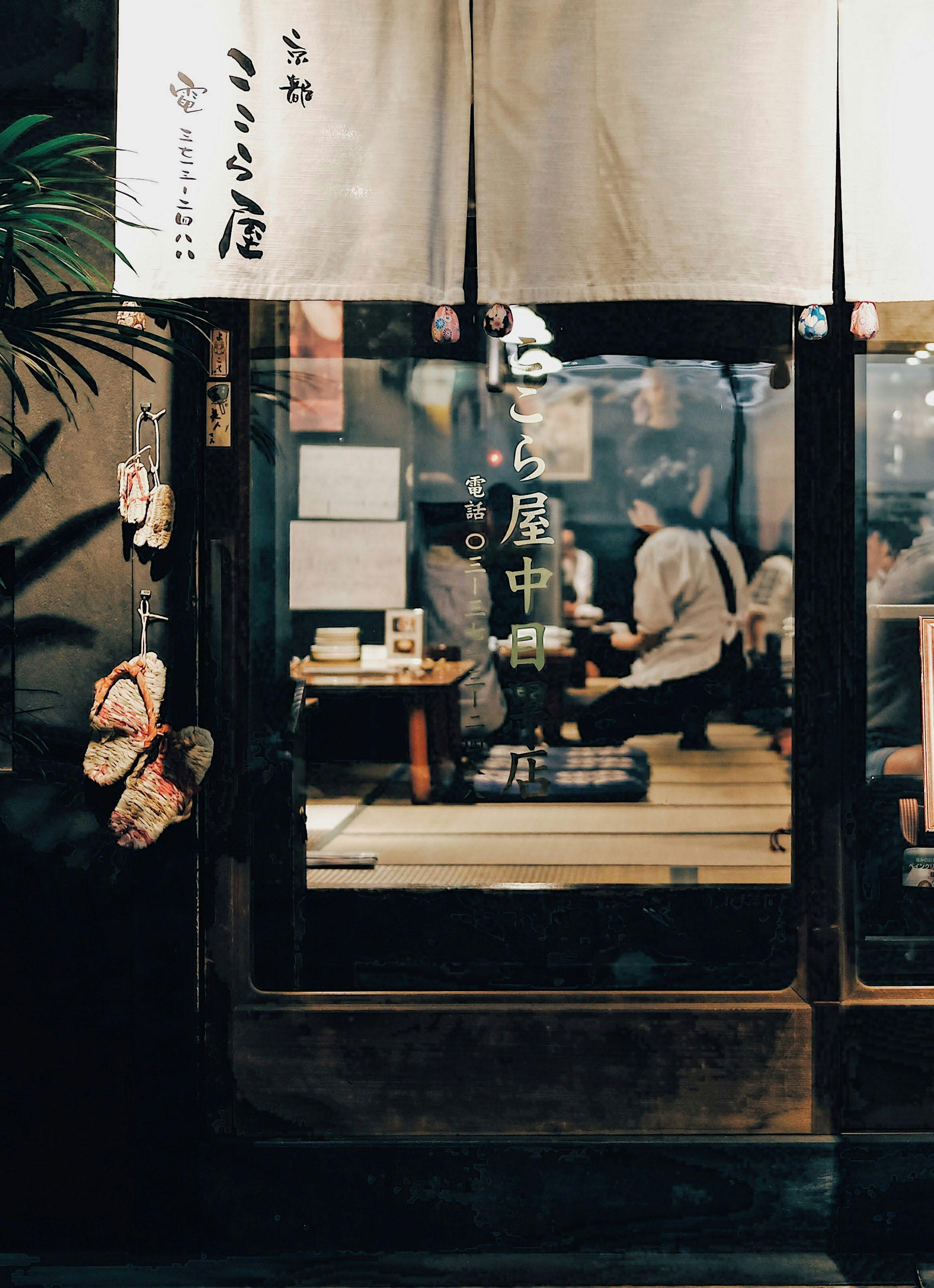
LANGUAGE COPY EDITOR
connect.ajet.copy2@gmail.com
Sofia de Martin
I’ve gotten lost in Tokyo Station a respectable three times. How many times have I been to Tokyo Station? That’s a secret I won’t tell!
CAREERS EDITOR & DESIGNER
kimberly@usjetaa.org
Kimberly Matsuno
Photo by Danis Lou | Unsplash.com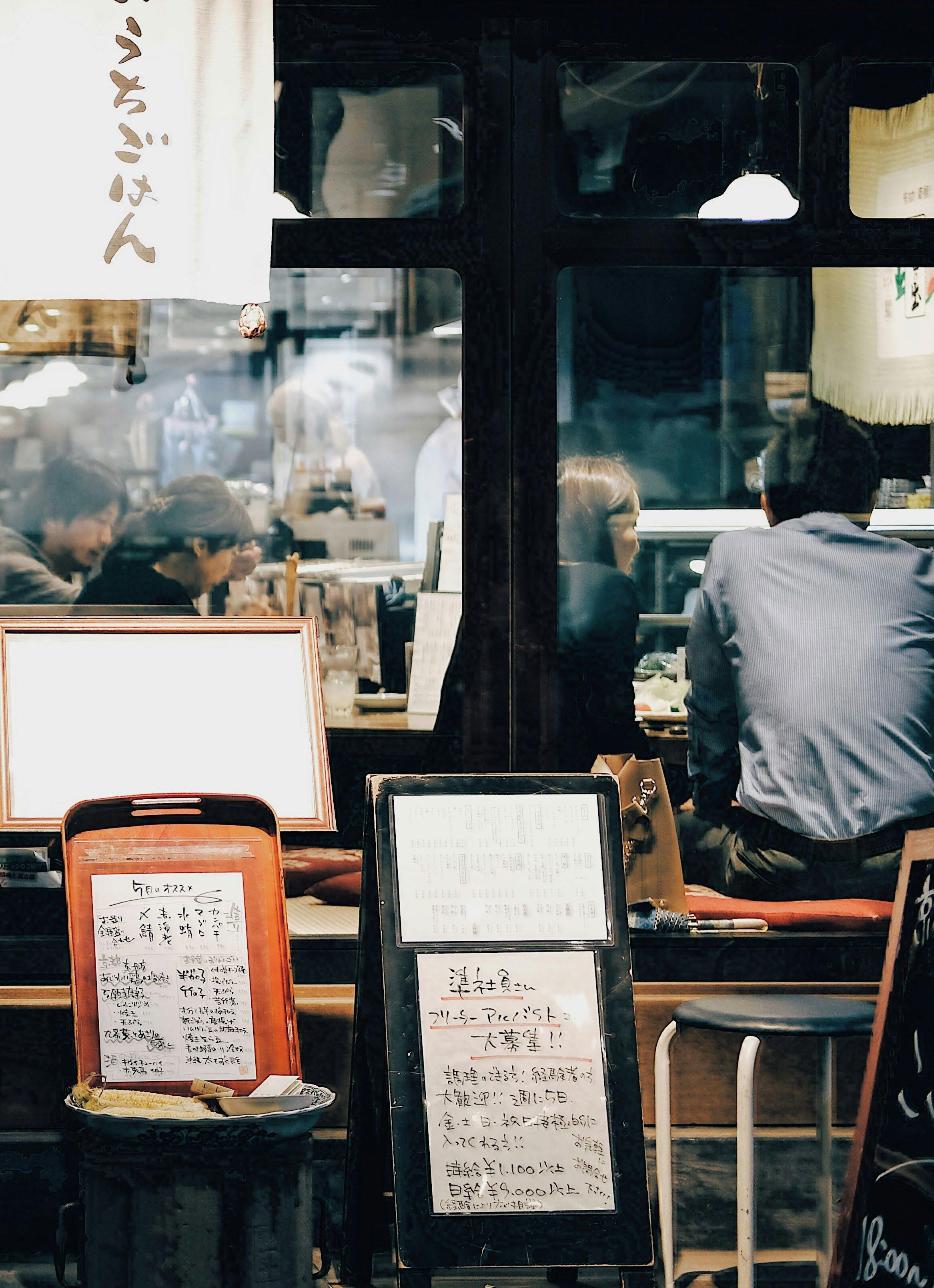



There is something I often tell people: while I was born and raised in the U.S., I became a full-fledged member of society in Japan.
I’d never worked a full-time job until I taught English in Japan. At twenty-one years old, I received a nomination to become an ALT through my university’s Sister Cities Program. My senior year was mostly spent (along with obtaining a secondary teaching license) preparing endless visa documents and mentally steeling myself to bid farewell to family and friends.
Two months after graduation, I moved 10,144 km across the world to Yachiyo City, Chiba. I still remember the surreal, dreamlike quality the



world had as I sat down in my little apartment, munching on edamame chips and listening to the unfamiliar, but soothing, five o’clock chimes. A storm brewed outside and I didn’t have any rain gear prepared; still, I felt oddly invincible.
It would not be an exaggeration to admit I hardly spared a second thought about my future career path during my time as an ALT. Those first three years were so immersive and full of adventure: it was like a spell had been cast on me, a second childhood.
Everything changed in my fourth year. An immediate member of my family was diagnosed with stage four cancer.
I signed paperwork to break contract, used my remaining nenkyuu to take care of cleaning and grieve. I packed nearly four years of my life into two suitcases in the span of twelve days. Then, I made the journey home.
Stranded back in America, in a constant high-stress situation, a reality I had avoided in Japan tackled me to the ground: the next step. I needed to provide for myself. I needed stability in order to weather the storm. The question to myself was: would those years as an ALT really amount to anything insofar as work? Had I spent all that time in Japan for nothing?

“The experience of working internationally has opened countless doors for me.”
Of course, the answer was no. A resounding no, at that. In fact, my time as an ALT has had a profound influence on every single career path I’ve embarked on since. The experience of working internationally has opened countless doors for me, ultimately bringing me full circle back to Japan, eight years after leaving. But it took me some time to discover the value of my ALT experience for myself. So, to help current ALTs experience a “softer landing” than I did returning home, I’d like to share where one of those first doors took me.
A year after moving home, I interviewed for the position of assistant instructor for an Intensive English Language Institute affiliated with my former university, the University of Texas at Tyler. The institute offered six different levels of language immersion courses for adults in America wishing to improve their English and go on to enroll in American universities. I taught students learning English for the first time as well as those already writing college-level dissertations.
It was my responsibility to create their syllabi, coursework, and exams for class. Having never taught English in such an environment before and not being the holder of an ESL certificate or a Master’s Degree, when I was found qualified and subsequently
position once I adapted to the workload.
My students at the institute were from all over—Vietnam, the Middle East, Kenya, China —and each brought with them, into my lectures, their respective reasons and ambitions (or lack thereof)
“That wasn’t something I could provide because I had a natural knack for it– it was because of my experiences as an ALT.”
selected for the role, I truly felt underprepared. Looking back, I imagine that I landed the job because of my experience overseas, teaching ESL in Japan, and my ability to adapt to and understand different cultures. Ultimately, that enabled my success in the
future of neuroscience; students who confided in me that they worked for employers that denied them lunch breaks, but that their need for the job kept them from taking any real action.



for learning the English language. I can remember to this day the variety of students who walked through my classroom door; students who refused to disclose their reasons for absence because I ‘was just a woman;’ students who gave impressive speeches on robotics and the
I would always tell my beginner students that I understood how they felt as adults starting from square one with another language. The frustration of being seen as less than you were because of your fluency level or having so many complicated thoughts and concepts that you want to express, but being years away from obtaining the vocabulary to do so.
I remember the relief in their eyes at my ability to empathize as well as their appreciation for how slowly and clearly I spoke without making them feel infantilized. That wasn’t

something I could provide because I had a natural knack for it—it was because of my experiences as an ALT.
The position also gave me the means to network all over campus. Admissions, student life, as well as various deans that held interest in prospective students and their respective fields. We arranged welcome parties, summer gettogethers, and various other opportunities to bring our students together with the rest of the community.

Working at the IELI also reunited me with Japan—a few months into the semester, it was announced that the mayor and a delegation from the city where I’d been an ALT would be coming to tour the university, including the institute. I had dined with the mayor many times in Chiba and when he discovered that I was working at the Language Institute, we were both delighted. It was arranged so that I served as his official guide and translator. While this did come about because of the Sister Cities relationship, I don’t believe it’s a stretch of the imagination by any means to think that in that position I still would have been called on to help with receiving such visitors from abroad.
I eventually moved on to new horizons, but my experience there continues to serve me well. In fact, not just myself, but others as well. I recommended a colleague of mine who had a dream of going to teach in Japan someday to the Institute—she received a job there and, later, her supervisors helped to recommend her for the JET Program.
However, what might have gotten through to me is the message I hope to have conveyed here: the ALT experience gave me a plethora of skills that I shouldn’t underestimate. It didn’t just give me a key to Yachiyo, but rather a ring full of keys for all the doors I would go on to open, including the one that led me right back here to Japan.
“It didn’t just give me a key to Yachiyo, but rather a ring full of keys for all the doors I would go on to open. . .”
I don’t think anyone could have warned me how hard the transition back home to America could have been. Honestly, even if they had, I wouldn’t have listened. Like most of life’s biggest challenges, it just had to sucker punch me.

Hayley Wallace currently serves as a Coordinator of International Relations (CIR) and Prefectural Advisor for the JET Program in Gifu. She has worked previously as a standardized patient director and a library reference assistant, amongst other roles. Her travels have taken her to South Korea, Cambodia, the Republic of Turkiye, and many other countries.




Erik Jacobs (Hyogo, 2013-2016)
U.S. and Asia Policy Manager, Access Partnership
Former White House Office of Science and Technology Policy
Advisor, Executive Office of the President
David Boling (Ibaraki, 1988-1989)
Director, Japan and Asia Trade, Eurasia Group
Former Deputy Assistant U.S. Trade Representative for Japan
Interview by Kimberly Matsuno (Niigata, 2019-2022)
Just as we’ve done with our previous spotlights, let’s start with the questions:
Erik: My grandfather was a WW2 veteran in Okinawa. I grew up hearing a lot of stories from him and found Japanese culture fascinating through his stories. But nothing really came from that until I went to Temple University to play football. After my time playing football ended, the honors program counselor suggested I go to Japan and study abroad at their Japan campus. However, my semester abroad was quickly cut short by the devastating Great East Japan Earthquake of 2011.
Even though my time in Japan was short, it solidified my interest in Japan and the Japanese language, and I ended up getting a certificate in Japanese back in the U.S. in addition to my Political Science degree. I applied to the JET Program after graduation because I still wanted that chance to live and work in Japan.
David: As for me, my interest in Japan happened a bit more by chance. A friend of mine was taking a Japanese class at the University of Arkansas and their professor mentioned the JET Program one day. My friend mentioned it to me in passing and it sounded like a good experience. There was a tremendous amount of interest in Japan in the mid-’80s, the salary was great for that time, and since the program was affiliated with the Japanese government, it seemed reputable to me. I was at a stage where I wanted a little disruption in my life anyway, so I applied. I ended up taking a year off from law school to participate in the JET Program.
So while we’ve all heard the term “foreign policy” in regard to federal governments, I’ve learned that the private sector also has foreign policies and hires people like you, policy managers. Can you explain what is policy management and what policy managers do?
Erik: A major part of my current job is to act as a consultant. I help clients manage and draft legislation, policies, and strategic plans related to technology. I inform them about what is going on in Japan (or Asia), in regard to technology, so they can make better-informed decisions for their company.
My job involves a lot of tracking what is going on policy-wise in Washington D.C. as well as Japan and finding the best way to support clients. The job involves a lot of communication and engagement with my network to stay informed.
David, currently, you work as the Director for Japan and Asia Trade for Eurasia Group, a firm specializing in political risk analysis and consulting. Can you explain the difference between political risk consulting and policy management?
David: Policy management (especially at the government level) is a lot about problem-solving. You usually have a specific problem that you are trying to fix with a policy solution. An example would be if a U.S. company had a problem entering the Japanese market due to a government barrier, you would try to make it easier for them by advocating to the Japanese government to make changes to laws or regulations to ease market entry for the U.S. firm.
As political risk consultants (for the private sector), our clients are mostly investors or global corporations that are trying to make future-oriented investment or business decisions. So we (as political risk consultants) assess future political risks for our clients that could impact those decisions. We share our analysis with our clients who use them to make their own investment or business decisions.
It’s important to note that Eurasia Group is not a think tank or a government relations advocacy organization. We are really in the business of
analyzing political risk and making forecasts for our clients. We are very future-oriented in our analysis.
We’ve discussed the differences between policy management and political risk analysis, but, David, you also served on the public sector side of things as a negotiator at the Office of the U.S. Trade Representative. What do trade negotiators do on a day-to-day basis?
David: Trade negotiators spend a lot of time writing memos! It may not sound sexy but it’s true.
While trade negotiators are like diplomats and often meet with foreign government representatives, a large portion of my job included writing memos for senior leadership. Those memos would prepare senior officials for key meetings or to make important policy decisions. I also was involved a lot in coordinating with colleagues from other departments (agriculture, health, etc) to provide the best information to senior U.S. government officials who then went on to negotiate deals with senior foreign officials.
Erik, Working as a White House Policy Advisor and being involved in such high levels of government as you have seems like an extraordinary (and elusive) career to many people. Would you say becoming a policy advisor for the federal government is a viable career path for JETs?
Erik: Japan is such an important ally to the U.S. that there are plenty of opportunities for JET alumni in the government. But you have to network and be deliberate about your planning if you want to work in the highest levels of government. I was very fortunate to get a political appointment, but I strongly believe that it was because of the connections I made and the network that I created for myself when I earned a spot as a White House intern.
I would strongly encourage current JETs and JET alumni to go to alumni events and just start talking to people. When I was in government, I found that JETs are everywhere—including in the White House
—and our shared experience always provided that instant connection. And I’ve always found that people love to help out younger people on their career path, especially if they feel a connection to them. So don’t be afraid to approach people at alumni or networking events. The worst they can say is they are out of business cards.
Would you say a degree in law, public policy, or political science is necessary to get started on this path?
David: I am often asked this question. And my answer is always “It’s not necessary, but it helps.”
Working in the federal government is a lot about specialization. Trade negotiations especially can be quite technical. So you really need to know a lot about whatever subject is being negotiated (agriculture, car manufacturing, etc).
I think it is a viable path for JETs if they are interested in trade, but I would stress that it’s important to think about all the government agencies out there. I always like to bring up positions in state government—because they so often get overlooked. State governments need people with international experience in areas like economic development. There are also political positions like working on a campaign, which can be very rewarding.
If you really are determined to work at the federal level, I also think Capitol Hill is a great place to work (especially when you are young). It’s a very dynamic place. Offices on Capitol Hill tend to hire more frequently and there is a lot of staff turnover. It’s a great place to get a foot in the door and build experience, which can then lead to an executive branch position.
Do you have any words of advice for JETs who wish to work in foreign trade/policy?
Erik: It’s important to find what specific issues motivate you and get to know them as deeply as you can. I strongly recommend reading across the spectrum and staying as informed as you can.
And know that it’s OK, and even advisable to find a niche interest where there aren’t a lot of people talking about it—because that’s often where opportunities are. But if you do so, you need to also find a way to explain why it is important and why people should care.

David: I also believe it helps to have expertise— outside of the JET experience—and to develop that expertise.
The JET experience is fantastic in so many ways, but it may not be enough to get you where you want to go. If you want to work on Capitol Hill or really in any section of government, you need to combine the JET experience with law or expertise in a particular field. To get into a career in foreign policy, you have to think of JET + X.
Erik Jacobs (Hyogo, 2013-2016) taught English as an Assistant Language Teacher on the Japan Exchange Teaching (JET) Program from 2013 to 2016 in the coastal city of Kobe-shi, Hyogo Prefecture. After returning from Japan, Erik worked in the White House Office of Science and Technology Policy and the U.S. Department of Energy. He has been involved in the U.S.-Japan relationship in various capacities, including as the project manager for the ministerial-level 14th Joint High-Level Committee Meeting on Science and Technology Cooperation at the White House in 2019 and staffing two Vice Presidential visits to Japan in 2018. Erik holds an MA in Asian Studies from Georgetown University and a BA in Political Science from Temple University. He continues to comment on U.S.-Japan relations in various capacities, with a focus on science and technology policy.
Kimberly Matsuno (Niigata, 2019-2022) is a JET alum currently serving as USJETAA‘s Programs & Communications Coordinator. She was an ALT in Niigata from 2019-2022, during which time she contributed to CONNECT Magazine as both a writer and a section editor. She is excited to continue contributing to CONNECT and to assist in fostering relations between current JETs and the JET alumni community.

The Career Section was created through a partnership between CONNECT and USJETAA.
The United States Japan Exchange & Teaching Program Alumni Association (USJETAA) is a 501(c) (3)nonprofit organization that furthers US-Japan understanding through the network of 35,000+ alumni of the JET Program and the 19 JET alumni associations across the United States
USJETAA promotes cross-cultural understanding at the grassroots level through support and resources for JET participants, alumni, and alumni associations throughout the United States. Thereby strengthening the capacity of the JET alumni network, enabling alumni to contribute to the greater US-Japan relationship, and fostering education and understanding of Japanese culture in the United States.
Based in Eurasia Group’s Washington DC office, David Boling (Ibaraki, 1988-1989) leads the firm’s coverage of Japan and works on Asian trade issues. Before joining Eurasia Group, he served for more than seven years as a negotiator at the Office of the U.S. Trade Representative, where he helped negotiate the U.S.-Japan Trade Agreement and Japan-related provisions of the Trans-Pacific Partnership Agreement. He has passed the highest level of the Japanese Language Proficiency Test.
Earlier in his career, David worked as an antitrust prosecutor for the U.S. Justice Department and spent one year in the Japanese government as a Mike Mansfield Fellow. Later, he served as the vice president of the Mansfield Foundation, which focuses its activities on Northeast Asia. He also spent time on Capitol Hill as the chief of staff to a member of Congress and launched a political candidacy of his own.[[I]]

USJETAA encourages all JET Program participants to join their local JETAA chapter in the U.S. or around the world for access to resources and support.
contact@USJETAA.org
@usjetaa
Though there isn’t any official definition, in language learning, the intermediate plateau can be defined as the sensation of stagnation when you’ve reached an intermediate level but can’t seem to reach an advanced level. You’re definitely not a beginner, but you’re not quite comfortable with calling yourself an advanced speaker either, as you still struggle with most native material, or when you want to talk about deeper subjects. In Japanese learning, you often hear about the huge gap between JLPT N3 and N2. I believe this gap is also due to the intermediate plateau to some extent, and it shows the struggle that many face in making the transition from intermediate to advanced Japanese.
As someone who experienced this feeling, and who finally feels comfortable calling herself an advanced Japanese speaker, I’d like to talk about my experience and give you some advice on how to overcome the intermediate plateau in Japanese.


I’ve been learning Japanese for six years, five of which were spent learning it at university. Having majored in Japanese, I was spending most of my time learning the language, and after two years, I truly felt like I had made tremendous progress. Then came year three, year four. . . and I wasn’t sure how to describe my Japanese level anymore. Although I had spent so much of my time learning Japanese, I still felt like I was lacking in so many ways. While I could navigate N3-level texts, that didn’t feel enough to read native material.
It wasn’t until my fifth and final year at university, when I wrote my master’s thesis and passed JLPT N2, that I truly sensed the transition from intermediate to advanced Japanese. Between the advanced material I engaged with for my thesis and my preparation for the JLPT, I was learning Japanese in a whole different way than I had until now.
During that time, I struggled with two things: adapting my learning method into one that was more adapted for advanced language learning, and finding learning material that was suited to my current level. These are the two points I’d like to give some Japanese-specific advice about in this article.
One of the great obstacles to advanced Japanese is kanji. When reading an advanced text, it’s probably not the grammar but the kanji that will stop you from understanding the meaning, therefore deterring you from going for advanced reading. This is where my advice comes in: consider changing your reading approach.
My advice is to select two separate texts for your regular Japanese reading and treat them completely differently. The first text should be approached academically, which is what you might already be doing: proceeding slowly, sentence by sentence, and looking up unfamiliar kanji, words, or grammar points. Write them down, revisit them for memorization, and proceed gradually.
Then, read the second text as if it were in your native language. Don’t stop to look up kanji or grammar; instead, continue reading and try to understand as you go, based on the words you do know. This approach might seem counterintuitive, but it will help you train your logic and reasoning.
Both ways of reading are equally important. The first helps you learn new vocabulary and grammar in context, while the second forces you to learn how to understand the general gist of a text when your knowledge is lacking. You’ll soon come to realize that you don’t need to know every single word to understand a text in a foreign language, and you’ll learn how to understand a text you don’t know every word of, which is a necessary skill to have in Japanese, as it will probably be a very long time before you reach a level where you never encounter unfamiliar words. (I mean, I got N1 a year ago, and I’m sometimes still baffled at how much I don’t know!)
Listening in Japanese might come easy for some people, while for others it might feel like the hardest part of the language. When I took N1, I remember thinking that the listening part was fairly easy compared to the rest of the exam, but talking about it with others, I realized that wasn’t the general consensus.
Just like with reading, I recommend practicing listening with two different approaches. The first approach is with active listening practice, using YouTube JLPT mock exams and other educational videos. Listen again and again to the recording to understand what is being said.
The second way is to incorporate passive listening in your daily routine, whenever you have the chance: on the bus, while walking, doing dishes, etc. When practicing for N2 and later N1, I would listen to native material way above my understanding, like the news or conversational podcasts. I only understood about 30% of what was being said, but it trained my ear to listen in Japanese, and in comparison, the listening part of the JLPT felt pretty easy.
One more thing I’d like to give advice about is the learning material. It can be quite hard to find material adequate to your level, when you find the intermediate stuff too easy, and the advanced stuff too hard.
First, I would recommend using intermediate-level textbooks in Japanese. It might seem demanding at first, as you’ll have to learn grammar terms in Japanese, but these textbooks are written in Japanese suited to the level you’re studying, and it’ll make you learn grammar and such from the Japanese perspective. One textbook I would especially recommend is the Shin Kanzen Master series, which is also an amazing textbook to practice with for the JLPT and has been my go-to since N2.
I recommend using websites such as the NHK’s News Web Easy, which publishes news articles written in simplified Japanese. It’s a good transition before you start reading news articles written for native speakers.
You can also read manga, as many of them come with furigana, which can help with the frustration of reading a text when you don’t know how the kanji are pronounced. As a general rule, try to diversify the media you consume in Japanese as much as possible, as it brings a feeling of newness and helps you learn different aspects of the Japanese language.
My final piece of advice is to be patient. When you started learning Japanese, you started from zero, learning basic words encountered in every sentence, so progress was very easy to see. Now that you’re more advanced, progress is harder to notice: you’re learning complex grammar and vocabulary that you see less of, but still need to know. Acknowledge how far you’ve come, and recognize that it might take some time before you reach advanced Japanese proficiency, but that this is normal when learning a language. And most importantly, hang in there!
Angelique is a first-year CIR from France working in Toyota City, Aichi Prefecture. She studied Japanese Literature at university. She enjoys reading, writing, and learning foreign languages. She also loves traveling around Japan and collecting goshuin stamps wherever she goes.
Illustrations in this article by Diana Valeanu, absurd.design
When it comes to getting groceries, reading the mail, or most other daily activities in Japan, you can generally get by with good ol’ Google-sensei. However, in the classroom, you can’t always rely on an app to do all the heavy-lifting. That’s why knowing even a little bit of the most common phrases/ vocabulary can make a world of difference. From building better relationships with students and JTEs, to helping you adapt to school life, finding even a little time to study is essential for every ALT. So, in this article, we will focus on a few key ways you can best fit language learning into your busy schedule.

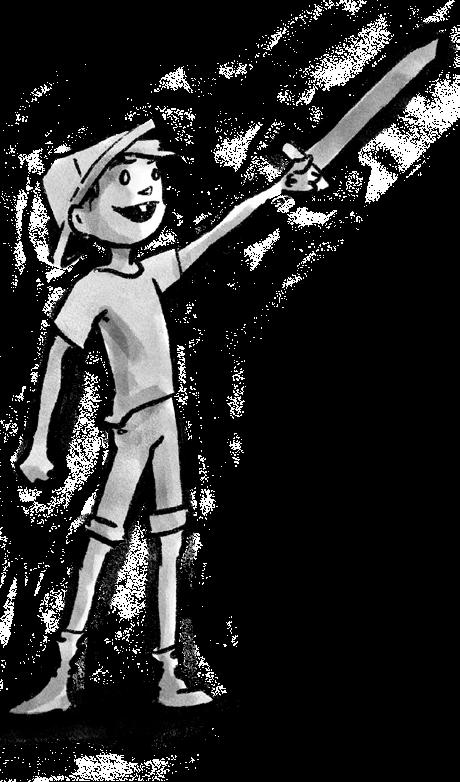
First and foremost, learn hiragana and katakana. If you haven’t already, I can’t stress enough how much of the language will instantly be unlocked by taking this first step. Since they are phonetic, you don’t have to worry about memorizing meaning, like with kanji. Instead, all you have to do is sound them out like you would with the alphabet and you’re all set. Not only can it be done in about two-four weeks, but they make up a lot of what is seen in the classroom. From nametags, vocab words, textbook material, and more, knowing these two writing systems gives you so much more agency to teach and help students.



Now that you’ve completed what’s essentially the game tutorial of Japanese, the way you learn becomes much more customizable. Like a “choose your own adventure” story, there are certainly faster and slower ways to the end, but what’s most important is that it’s enjoyable and fits your life. For instance, I know an ALT who spent two years working through James Heisig’s Remembering the Kanji (RTK) textbook series and can read nearly anything at school or elsewhere because of it. I, on the other hand, got burnt out after two months and ultimately changed course. If you’re like me and squirm at the thought of diving into another textbook, there are plenty of other easy ways to start learning.
Ah yes, the humble podcast. It might not seem like much, but regularly listening to podcasts in Japanese is one of the most versatile ways to learn. This is because you can turn one on while driving, out for a run, cooking, etc. The point is there is almost never a time outside of work where you can’t get some valuable listening practice.
Not only that, but the more you listen, the more you’ll be able to understand. You’ll also slowly build up an arsenal of useful phrases like “どういう意味” (What do you mean?) (1) and, “名前は何ですか” (What’s your name?) (2). It’s simple, easy to learn phrases like these that help you engage with students. My personal favorite is asking, “これは日本語で何 と言いますか” (How do you say this in Japanese?) (3) when a student is studying vocabulary or drawing a picture. This reverses the rolls, allowing the students to teach you new words that are relevant to your class.
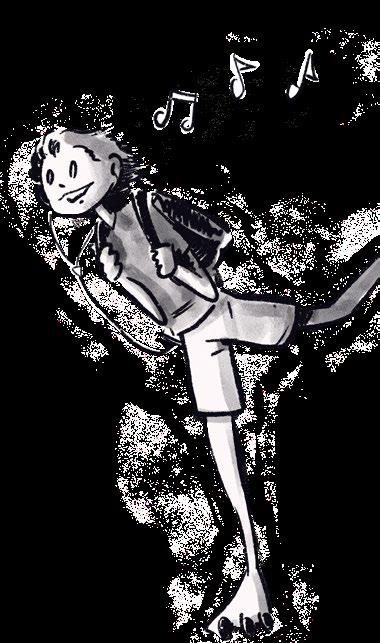

While there are thousands to choose from, the hardest part is knowing which podcasts are at your level. Some of the best ones I’ve found for beginners are “Japanese with Shun”, “The Bite size Japanese Podcast”, and “あかね的日本語教育” (4). These tend to speak around the N5-N4 level and make use of really practical, everyday conversation. For mid to higher levels like the N3-N2 I’ve used “Miku Real Japanese” and “YUYUの日本語Podcast” (5). With less restriction on what they can say, both get into more entertaining topics and let you really challenge your listening ability. Plus, all of these I’ve mentioned have video versions for even more immersion.

Another really convenient way to study is YouTube. While you may think you’ll need to spend hours of your week at a language school to properly study, the reality is nearly everything you’ll need to know about Japanese and for your class is already online for free. Unlike podcasts, though, the video element is invaluable since you can see the words on screen, as well as the context behind them. Even just a video of someone walking down the street in Tokyo having a chat can be great for learning. This is especially helpful for the many onomatopoeia which often have a very visual image attached to their meanings.
These are perfect to pop on real quick while having a meal, riding the train, doing laundry, and more. The best part is many of the channels are very entertaining, which helps studying feel less like, well, studying. My personal favorite is a channel called “Game Gengo” which uses video games to teach Japanese. Currently, it has videos covering every single grammar point needed to pass the JLPT N5-N3, as well as most of the vocabulary. It even has recommendations for games to play in Japanese yourself, which is a whole other way to learn in your downtime. While this is just one example, there are hundreds of other language learning channels to fit your interests.

Let’s face it, we all love to kick back after a long day and relax with our favorite shows. There is nothing like spending an hour or two getting lost in a good story, right? However, that time actually presents a golden opportunity. Instead of watching things you already know, why not try finding a show or film in Japanese? I’m not just talking about anime either. Recently, there has been an explosion of high-quality productions that are just as fun to watch as they are to study with.
Once you find one you like, then you can start what’s called shadowing. This just means you repeat what the characters say on screen the best you can. You can begin with English subtitles, but as you get better you can switch to Japanese ones. If Japanese media isn’t your thing or you just want to watch your favorites, you still can. For instance, Netflix has tons of shows like Brooklyn Nine-Nine that can be watched all in Japanese with your preferred subtitles.
Doing so will help you remember those key everyday phrases which you can use in the classroom and to strengthen your speaking muscle memory. This “have your cake and eat it too” approach works so well since you’re not sacrificing your downtime, you’re just making better use of it. While it’s not quite as convenient as just throwing on a podcast, it might just become the most fun study method in your arsenal.

Perhaps more importantly, though, is that you’ll be learning language your students actually use. Words like: kimoi (disgusting), sugoi (amazing), maji (seriously), are all common slang words I’ve become familiar with from casually listening to podcasts, videos, and shows. In a formal setting, you’d almost never need these, but in the classroom with excited kids, they can become the bread and butter of the conversation. That’s why getting to know the informal language used outside of textbooks can give you such an advantage at school.


Ultimately, the main benefit of using these study methods is that you’ll be learning Japanese that can be directly related back to your students, all in time you never thought you had. While serious sit-down study with things like WaniKani, RTK (RememberingtheKanji), or the Genkiseries should never be shunned, taking advantage of these little windows of opportunity throughout your day just might be your easiest path to better learning and teaching.
1.どいういみ - doiu imi
2.なまえはなんですか - namae wa nan desu ka
3.これはにほんごでなんといいますかkore wa nihongo de nan to iimasu ka
4.あかねてきにほんごきょうしつakane teki nihongo kyoushitsu
5. YUYUのにほんごPodcast - YUYU no nihongo Podcast
Justin Dobbs is a first-year JET in Ehime Prefecture. He is determined to pass the JLPT N2-N1 while making it fun and practical. On the weekends, you can usually find him cycling around the Shimanami Kaido or getting lost finding new trails.
Illustrations in this article by Levi and Lily Nunnink, Humanities Studio.

TRAVEL EDITOR
connect.ajet.travel@gmail.com
Jon Solmundson
The navigability of Tokyo Station on any given day is directly proportional to the amount of time you’ve got before you need to be somewhere. Arrive with time to kill and it shrinks down to nothing, devoid of sidetracks and amusement, but if you’re rushing to get somewhere on time the labyrinth unfurls before you.
TRAVEL DESIGNER
connect.ajet.assistantvm@gmail.com
David Spencer
Sorry, I blacked out for a moment there. What did you ask me?

COMMUNITY EDITOR
connect.ajet.community@gmail.com
Nabeela Basa COMMUNITY DESIGNER
connect.ajet.assistantdesigner3@gmail.com
Aaron Klein
Aaron has never gotten lost in Tokyo Station, if only for the fact that he simply hasn’t managed to find his way there yet.
TRAVEL & COMMUNITY COPY EDITOR
connect.ajet.copy1@gmail.com
Zoë Vincent
I’ve gotten lost on the way to Bubby’s multiple times actually.
Photo by Jonathan Forage | Unsplash.com
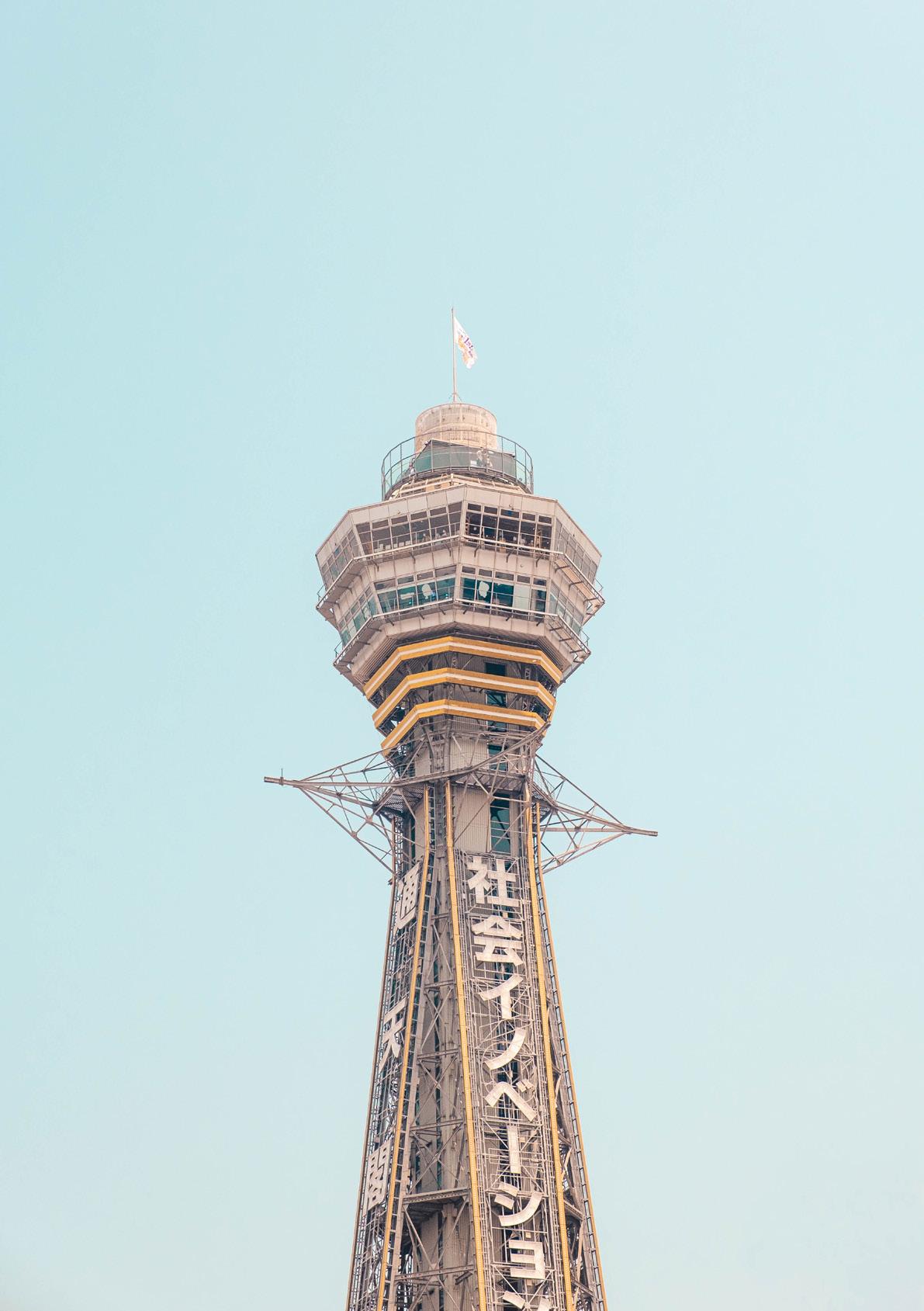
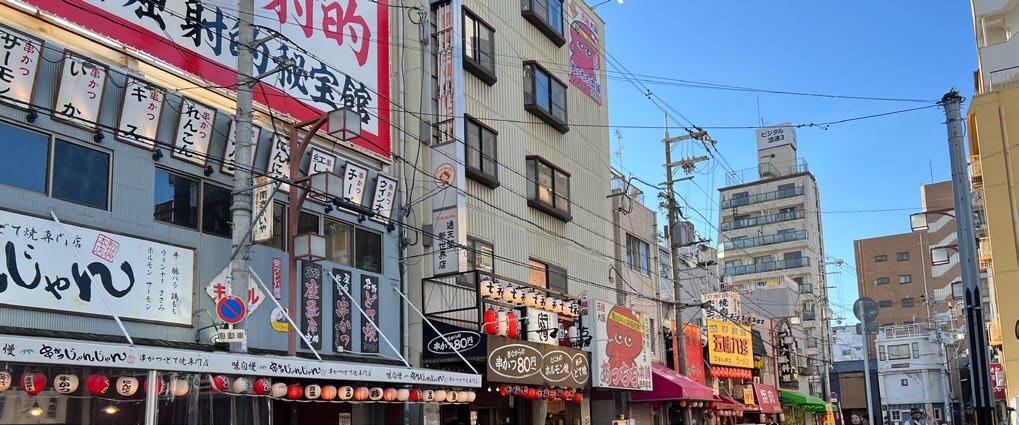
The neon lights of Dotonbori street, illuminating one-of-a-kind street food creations, screaming at your senses to “try me.” The sizzling sound of stillcooking takoyaki, beckoning you to the tasty local specialty like a siren’s call. A towering behemoth of a castle surrounded by a beautiful garden, protected on all sides by a moat. These are a few things that might come to mind when one thinks of Osaka, but there is one location just as deserving as the rest that is spared no thought. Shinsekai (新世界 literally, “new world”) was built shortly after the turn of the 20th century as a showcase of Japan’s successful industrial revolution and its new status as an emerging global superpower.
The southern half of Shinsekai was modeled after Coney Island in New York, while the northern half was modeled after Paris, although I didn’t see the resemblance when I visited. The center piece to all of this was the Tsutenkaku Tower, originally designed to resemble the Eiffel Tower, if it was built on top of the Arc de Triomphe. In the days of yore, Shinsekai truly was a new world. A cable car ran overhead, which connected the tower with the nearby Luna Park. Shortly after Shinsekai’s construction in 1912, Tennoji Zoo was built in 1915. Although many things faded away with the passage of time, the zoo remains to this day.
Shinsekai feels like a bizzaro alteration of history that would feel more at home in an episode of the Twilight Zone as opposed to the physical reality we embody. The tower I saw, rebuilt since its construction, doesn’t resemble the above description in the slightest. All traces of the Arc de Triomphe were twice stripped away—once by a fire that damaged the tower in 1943, and again when it was disassembled shortly after for scrap metal, the resources repurposed for the then-raging war. The faux Eiffel Tower now has more in common with an alien spaceship. The new octagonal structure with the letters “HITACHI” blazing down the side showcases the proud sponsors of this creation. Everything about it looks fake, but in a way that’s so unabashedly authentic.
With all the subtlety of a circus sideshow, there’s something undeniably endearing about this strange place.
When you visit Shinsekai, you are greeted by a sign that reads “Sin-Sekai” in stylized neon letters—a relic from times before there was a standard romanization style for Japanese characters. You don’t need to walk far to be right under the Tsutenkaku Tower, and you can look up and see the intricate mural painted underneath, depicting peacocks and a variety of flowers. Shinsekai was smaller than I expected, and makes for a perfect half-day trip for any Osaka-bound travelers—a trip I say is very much worth it.
Image credit: Martina Comorkova (Okinawa)I’ve always considered myself a foodie, and so I felt it was my duty to visit Daruma, the original store where kushi-katsuwas invented. Kushi-katsu is a convenience food you can find all over Japan. Seemingly anything can be transformed into this humble dish, as long as it’s fried and on a stick. More on that one later. The very first kushi-katsu store was opened in Shinsekai by a woman named Momono Yoshie, a restaurant owner who made her money by selling the newly invented speciality to blue-collar workers hoping to fill up for a cheap price. For dessert, I stopped by a sweets and ice cream shop. I ordered a chiffon cake that was well beyond Instagram worthy and would feel right at home on any high flying influencer’s social media feed.
Something I couldn’t help but notice was a little figure that could be found all over the place. Shinsekai has a mascot of its own, with a quite unusual origin. Billiken has pointed ears, with his big feet stuck out so his soles face the viewer. There are a few things you should know about him. He’s said to bring good luck, and is the god of “things as they ought to be.” His presence is unavoidable around Shinsekai, which is remarkable because you’ll almost never see him anywhere else in Japan. Lastly, he was designed by an art teacher from Kansas City, Missouri in 1908 and is the athletic

mascot of The University of Saint Louis, on top of being an enshrined god in Japan.
Next, I chose to head up Tsutenkaku during the day to get a good view of the surrounding Osaka cityscape. As beautiful as I’m sure the skyline would be lit up at night, I was worried the sparkling lights would drown out the possible cityscape and make it difficult for me to see how far the view reaches from atop the tower. On the elevator up, a short video is played about Shinsekai, and the room goes dark. A lit-up illustration of Billiken comes to life on the ceiling, reminding visitors under whose good grace it is that Shinsekai prospers. The route down from the observation deck takes you through a museum dedicated to Shinsekai’s history, and it becomes very apparent that the one thing keeping Shinsekai running is pure, unadulterated capitalism; signs for Glico, Pringles, and Kinnikuman are plastered over every exhibit, almost like a wall of advertising you have to click through to read the historical information, but they feel right at home next to the shrine of Billiken (where I made sure to pay my respects). The products of the tower’s inescapable sponsors also fill the gift shop you walk through on your way to the exit, leaving no room for the tasteful selection of local rice crackers and cookies that usually feature in Japanese souvenir shops. This place is a mess and I love it.
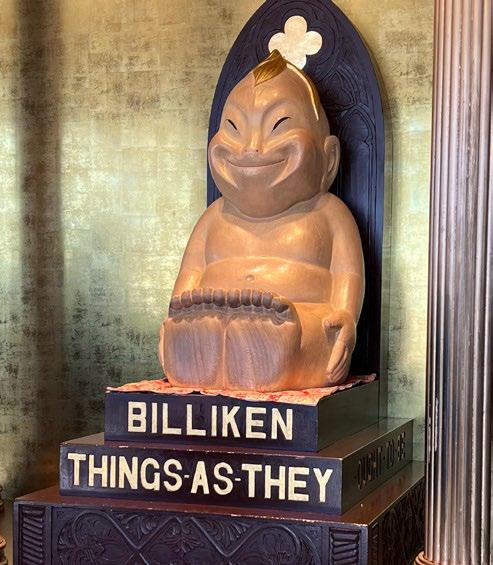
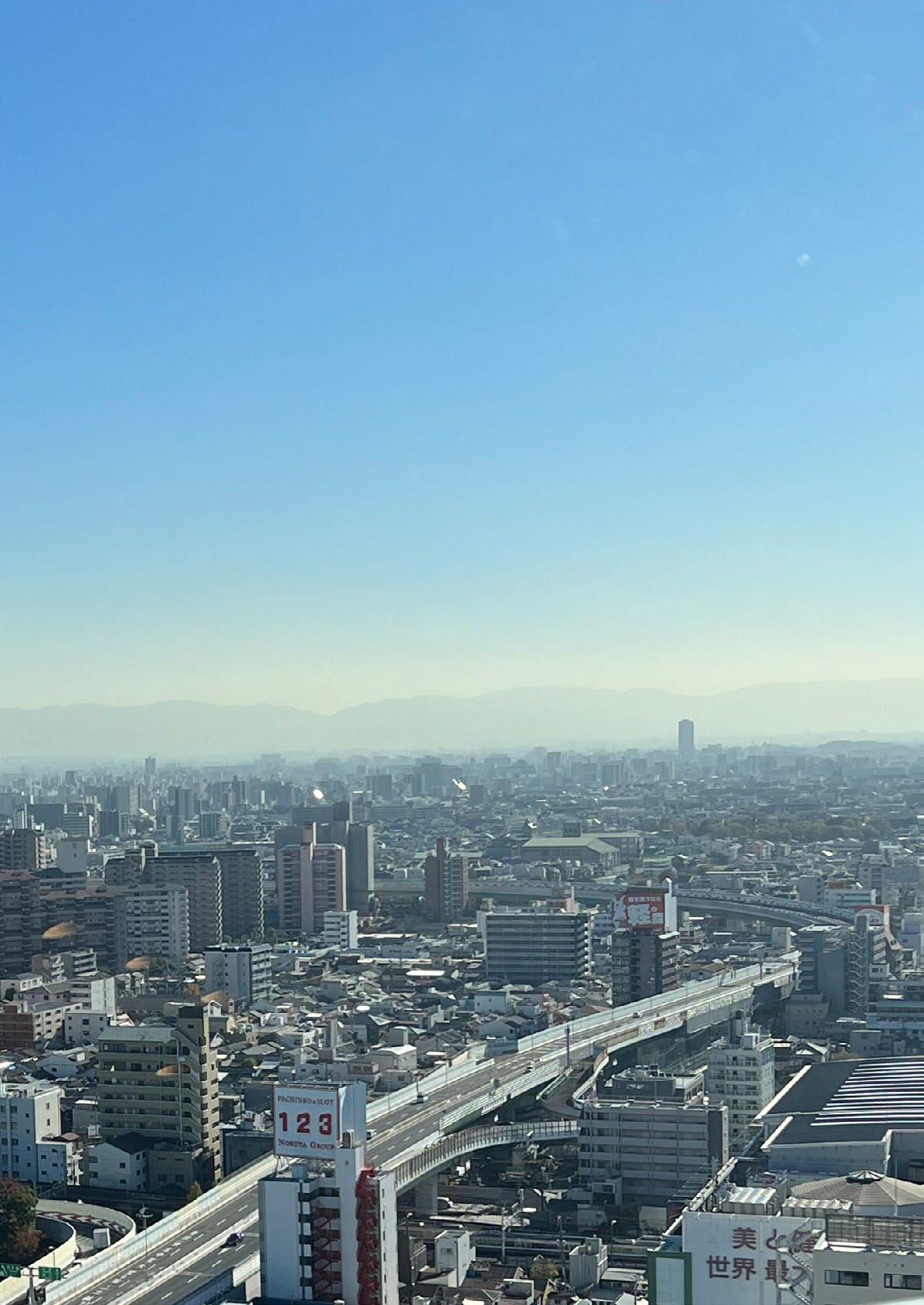
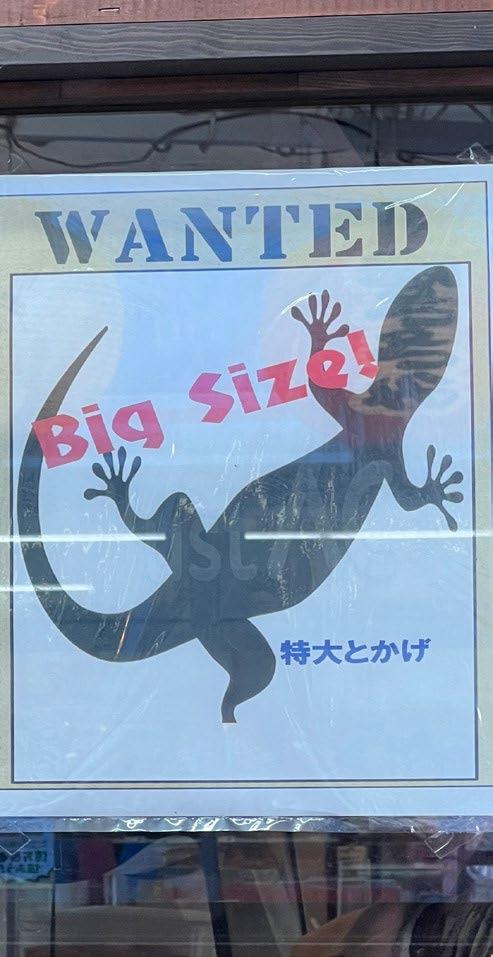
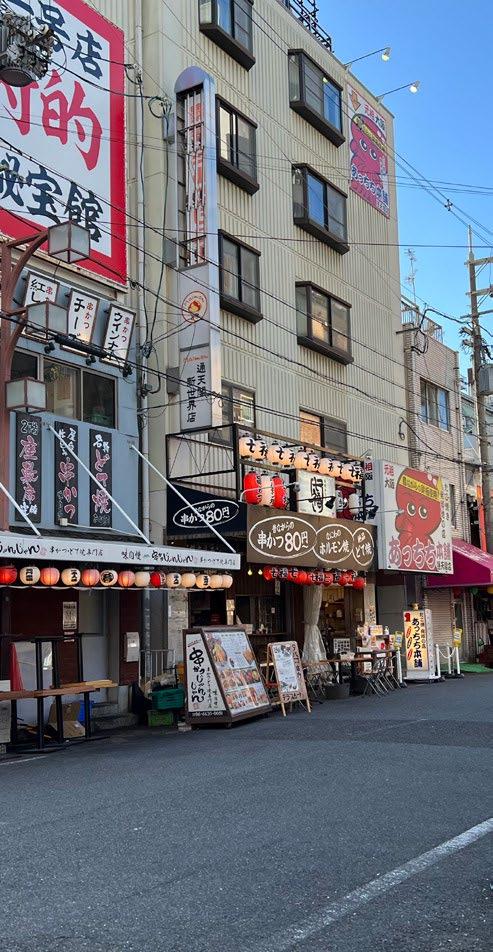
I spent the rest of my afternoon walking around and soaking in the sights. One thing you’ll quickly notice is just how weird Shinsekai is. There was an unmanned “store” that had adult-only gachapon capsule machines on one wall and a small crane game where you could only win plastic crab claws on the other. In the far back was a Punch-Out!! arcade machine. It’s a mystery how this store pays its rent, and not one I’m willing to solve. Oh yeah, and about the kushikatsu. . . when I said kushi-katsu only needs to be fried and on a stick, I meant it. While many of the kushi-katsu restaurants were fairly ordinary, not all of them were. A sign for lizard, scorpion, and grub kushi-katsu stood next to plastic mock ups of the more typical fare, as well as a bounty requesting large reptiles.
The not-so-weird parts of Shinsekai feel frozen in time. As a resident of Japan, it’s the only place I’ve encountered, outside of a festival, where people could have fun shooting with a cork gun, or even a bow and arrow. Gachapon machines are littered all throughout Shinsekai, and it’s recommended that visitors keep their eyes peeled; it’s not uncommon to encounter something that is entirely out of production, having fallen out of fashion everywhere else.
Image credit: Martina Comorkova (Okinawa)One Shinsekai highlight that feels truly one of a kind are its retro arcades. Their oldest cabinets proudly state their age. There’s something special about getting to play Pac-Man on a cabinet labeled “1983”—old enough that it has been around since the very beginning, when history was being made. Tragically, or perhaps obviously, I was unable to take any meaningful pictures of these wonderful machines; CRT screens are impossible for my camera to capture properly.
The sun had set at this point, and the city lights were springing to life. Earlier that day, shortly after lunch, I passed by something unmissable: a restaurant with a too-large-tocapture-in-one-photograph boat decorating the outside. Upon looking through the window, I saw a faux boat inside as well. It was a seating area for customers, surrounded on almost all sides by tanks filled with fish and labeled with menu items and prices, with guests allowed to catch their own fish for dinner. The restaurant provides customers with the necessary tools required for the endeavor. It was a bit nerve wracking for me; I’ve only ever gone fishing a couple of times as a young child, so this effectively felt like my first time. I was absolutely over the moon when I caught a flounder of my own.
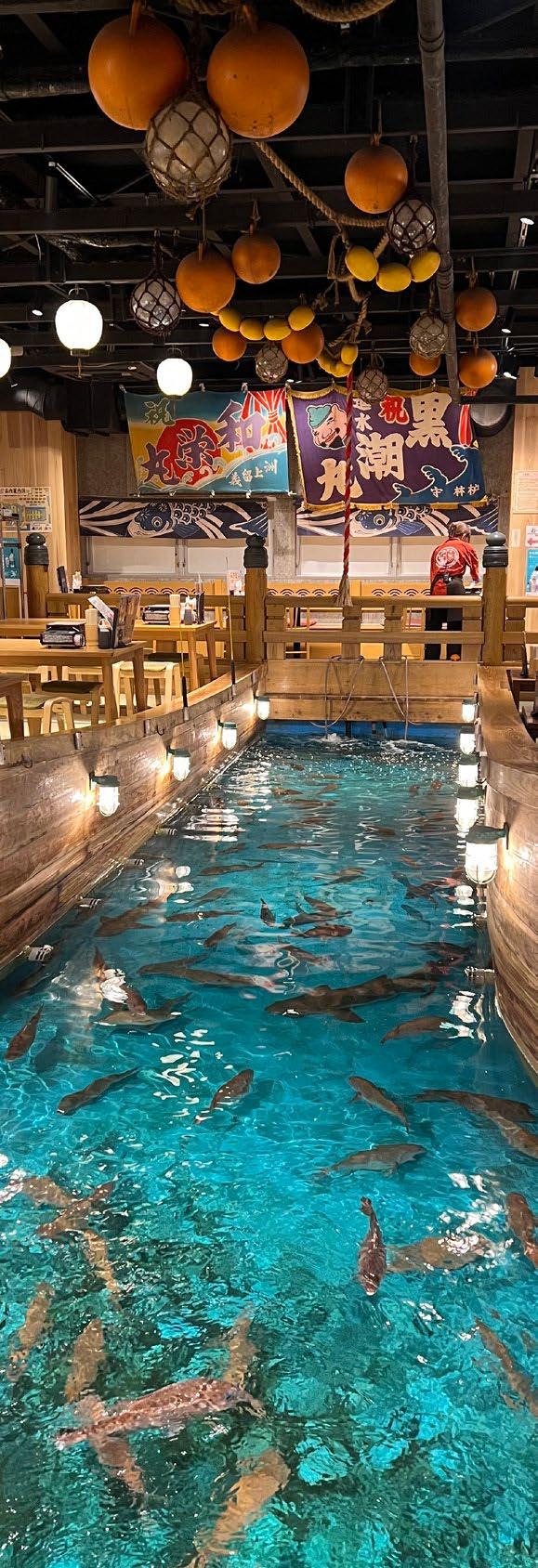
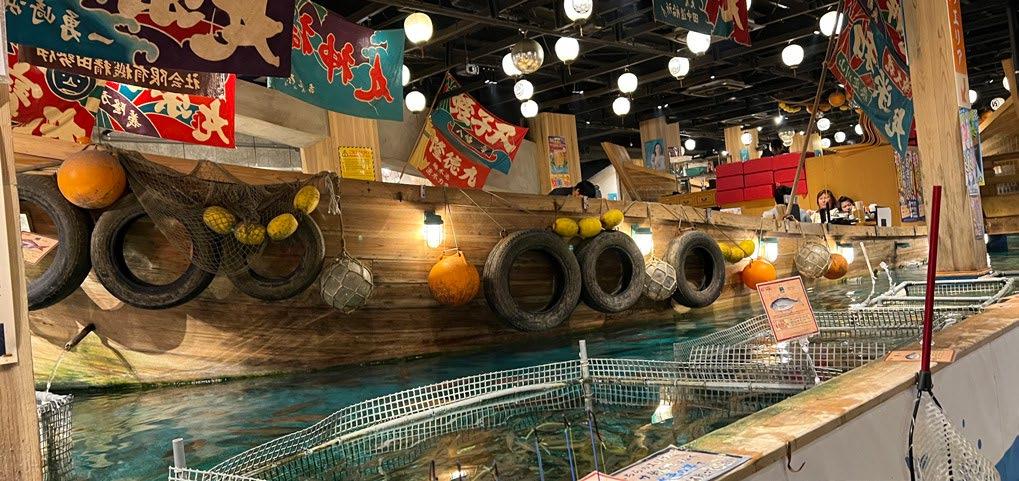
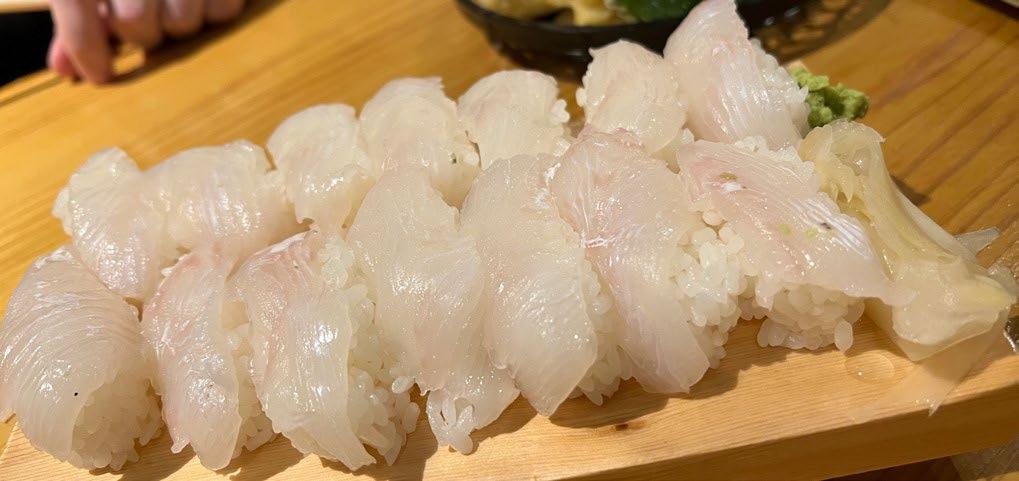
That was when it dawned on me that I just sentenced the little still-flopping guy to his end. It was a blink-and-you’ll-miss-it sort of internal crisis. I almost threw in the towel there, and reconsidered becoming a vegetarian. The thing that kept my head in the game was the fact that I was a carnivore and always have been. It felt wrong to back out now—hypocritical even—when this is essentially what I was doing every day but with extra steps. So please, as a customer, keep in mind that while you will certainly have no problem enjoying the couldn’t-possibly-be-fresher fish, be sure you can stomach the delicious burden that comes with catching your own dinner.
Full, fulfilled, and freshly enlightened, I headed back towards my hotel. All in all, Shinsekai is a once-long-forgotten place whose community didn’t let it die. Now, it’s filled with things you truly can’t find anywhere else. But it isn’t a place you can accidentally stumble upon on most Osaka itineraries; it might take some deliberate planning to get yourself here. I had the good fortune of coincidentally choosing a hotel a stone’s throw away, giving me the opportunity to pass through Shinsekai a small handful of times. No matter how often I passed through, I found something new, but could no longer find something I had sighted the previous times.
Image credit: Martina Comorkova (Okinawa)Shinsekai was initially built because of the pioneers of the industrial revolution, and was kept on life support by the bold people who believed in it once that chapter had run its course.
It’s the kind of place to reward explorers who are willing to take a trip and see it for what it is—a tempest of past, present, and future. I recommend it for anyone brave, and willing to ride the storm.

Martina Comorkova is a second-year ALT in Okinawa and a huge fan of games. When she isn’t in the middle of a game, she’s absorbed in books, honing her craft as an aspiring writer.
Title page credit: David Spencer (Kyoto)
The truth, however, was something far different than what I could have ever imagined. Far from being a plain, forgotten island, Kyushu is an underrated gem of Japan. With sparkling seas, snow-capped volcanoes, magnificent smaller islands, and ancient ruins, it’s a land worthy of exploration.
Blessed with easy access to mainland Asia, Kyushu has earned the nickname “Gateway to Japan,” and—while not nearly as populated as Honshu—it serves both travelers and locals alike with a diverse transportation network. However, in my five years of living here, I’ve found that if you want to truly enjoy every one of this island’s many treasures, your best bet is to get behind the wheel yourself and hit the road.
Despite being named “Nine Provinces,” Kyushu today has seven very distinct prefectures. While you could drive from north to south in a little over five hours non-stop, each of these places has a lot of curious secrets to delve into: You could plan a weeks-long tour and still not see it all. To explore it fully, we’ll cover north and west Kyushu in Part One (this article) with Part Two to follow in a future edition of CONNECT, which will cover the east and south regions. So, whether you’re planning to make the trip yourself, or just want to join us for the journey on the page, let’s take a look!

This is where our trail begins, as we cross over the Kaimon Straits (1). Featuring a bridge spanning both islands and some unusual, old European-style structures, the area is host to spectacular fireworks during the summertime. You can also enjoy trying various types of blowfish!
From here, our next major stop will be Kitakyushu City (2), which hosts a number of museums and a beautiful castle. However, one of the city’s most sought after spots is nestled deep in the mountains that surround it. Following some twists and turns in the road, we find ourselves at the Kawachi Fujien Wisteria Garden (3). Here, the trees have been shaped into a beautiful purple tunnel over the winding path, which leads to an upper viewing area covered in a canopy of purple flowers. The area is so gorgeous, in fact, that it’s considered one of the best flower spots in Japan.
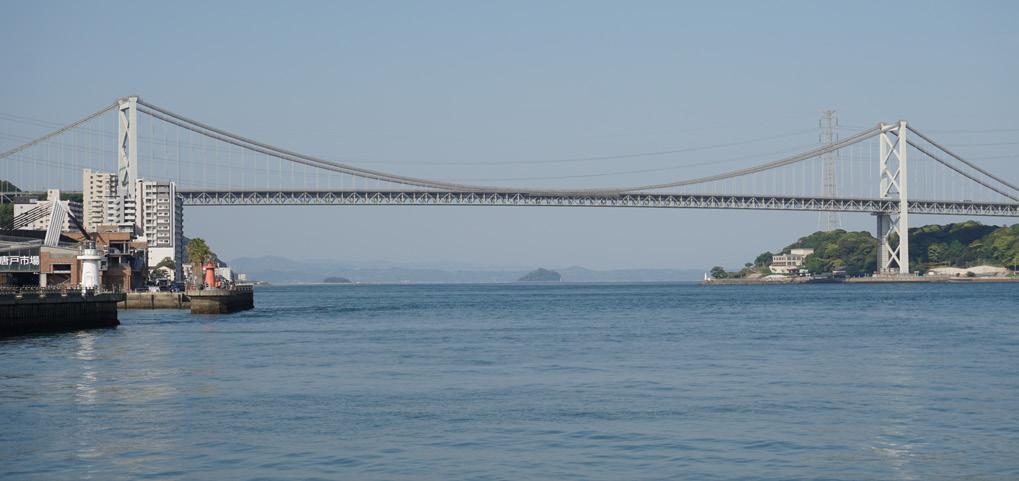
Beyond Kitakyushu lies Fukuoka City (5), the heart of the prefecture. Unsurprisingly, it’s also filled with a host of places to visit.
As we approach, one great opportunity for a sightseeing stop is Miyajidake Shrine (4), which features the famous “Path of Light.” For a short period in October and February, the setting sun perfectly aligns with the main road that runs from the shrine to the sea. It’s definitely a must see for those that enjoy sunset photography.
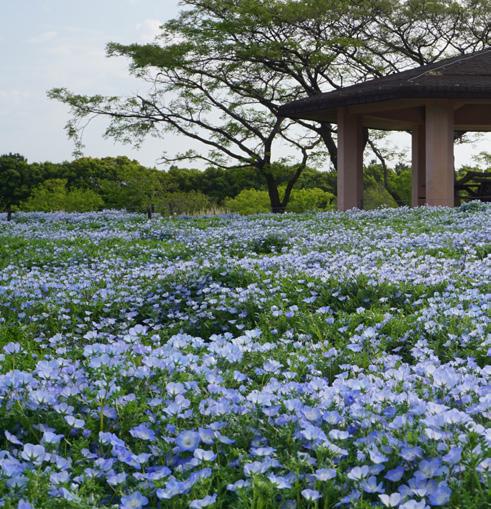
Then, for a taste of the beautiful seaside, just outside Fukuoka City itself is the Uminonakamichi Peninsula. Hosting Marine World and the sprawling Uminonakamichi Park (6), it’s a wonderful open space you can enjoy all year long. One of my favorite features is the elegant fields of blue nemophila flowers in April.
 Image credit: Mark Christensen (Fukuoka)
Image credit: Mark Christensen (Fukuoka)
Image credit: Mark Christensen (Fukuoka)
Image credit: Mark Christensen (Fukuoka)
Taking a stop in Fukuoka City, we’ve got a chance to cheat a little bit on our crossKyushu route, and jump forward to the islands of Iki and Fukue (7)—which are technically in Nagasaki—since this is a great place to catch the ferry over.
Iki is to the north, and is definitely best experienced with a car. Two notable spots worth visiting on the island include Sariwa, the Monkey Rock, and Kojima Shrine. The first is a rock formation with an uncanny resemblance to a giant monkey, while the second is a small island shrine with a path that can only be reached during low tide.
To the southeast, Fukue is one of the main Goto Islands. Once a refuge for the “Hidden Christians” (mentioned more later on), the island contains some of the oldest churches in Japan, while the beaches offer stunning cyan-blue waters. On a clear day, the island’s Osesaki Lighthouse offers a beautiful view of the setting sun.
Returning to the main island, the highway south of Fukuoka City leads past Dazaifu Tenmangu Shrine (8). Dedicated to Sugawara no Michizane, a historical scholar deified as Tenjin (“god of learning”), it’s one of the most popular places for students hoping to pass their exams. Each year on October 18 a special prayer ceremony is held for students, marking the date Michizane passed a particularly challenging exam, though students also make regular pilgrimages throughout the year to pray for good luck.

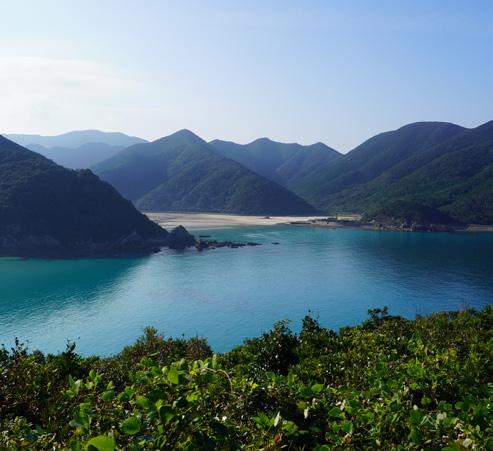
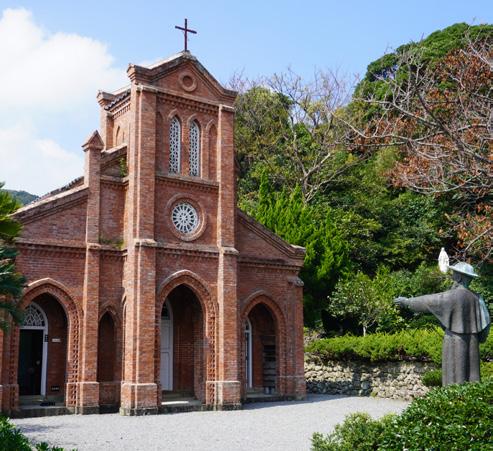 Image credit: Mark Christensen (Fukuoka)
Image credit: Mark Christensen (Fukuoka)
Image credit: Mark Christensen (Fukuoka)
Image credit: Mark Christensen (Fukuoka)


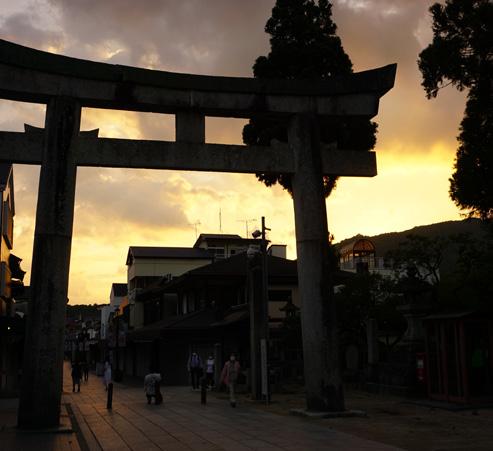
While the shrine itself is currently under renovation, the grounds are home to beautiful displays throughout the year, including the Onisube Fire Festival, Tanabata, and Plum Blossom Ceremony. The Kyushu National Museum—which hosts a number of Japan’s most important cultural treasures—is on the edge of the shrine grounds, while Kamado Shrine—regarded as one of the inspirations for popular anime KimetsuNoYaiba—is only another five-minute’s drive from the museum.
Continuing south, the landscape opens up before us with the massive Chikugo Plains, home to large cities like Kurume and Chikugo and rural farming areas like Yame and Yabe.
While it may not look like it, this region has a surprising connection to love. In Yabe, the narrow mountain roads lead to the “Heart Rock,” a natural rock formation resembling a classic heart design, while Koinoki Shrine (9) in Chikugo is covered in heart symbols and pink paint.
Fukuoka’s southernmost city, Omuta, isn’t a stop on this particular journey, as we’re now going west. Still, Omuta is not to be missed. Braced between coastal mountains and the beautiful Ariake Sea, the city is definitely worth the drive. In the spring, the city’s Fukoji temple has brilliant pink and white plum blossoms while the annual Daijiyama dragon festival, a dancing parade, attracts hundreds of thousands of visitors in summer.
Image credit: Mark Christensen (Fukuoka) Image credit: Mark Christensen (Fukuoka)Crossing over from Fukuoka, one of the first stops we can enjoy is the Chikugo River Lift Bridge (10). An antique from the 1930s that was once showcased in France, it was used to help trains cross over the heavy boat traffic of the Chikugo River. It was reopened again in the mid1990s, and can now be traversed on foot!
Just outside of Saga City (11), the roads lead to one of the island’s most iconic aerial displays. In November, the prefecture hosts the Saga International Balloon Fiesta, which is one of the largest hot air balloon events in Asia. Attracting vendors and massive crowds, this festival also features nightly displays where visitors can see the balloons flare their engines along to the beat of music.
To the north, and across the mountains, we can visit Karatsu Castle (12). While the original castle was destroyed during the 1870s, the current castle is still quite scenic. At night, the castle is sometimes beautifully illuminated with purple and blue lights. This isn’t Saga’s only notable illumination display, either. Mount Mifune (15) on the outskirts of Takeo City features a park with an impressive maple tree light up during November.
A short drive away, we happen across two very interesting holy sites. The first, Takeo Shrine (13), is home to Japan’s sixth largest tree, a 3,000 year old Camphor tree. It’s so big, in fact, that there’s a shrine inside its trunk! The other site is Yutoku Inari Shrine (14), one of the most important Inari shrines in all of Japan, said to be on the level of Fushimi Inari Shrine in Kyoto.
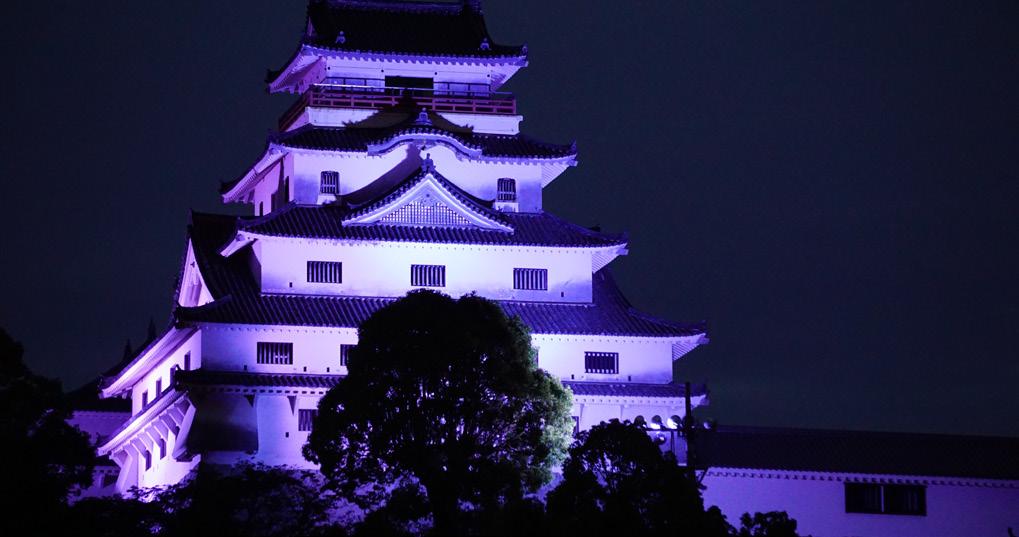
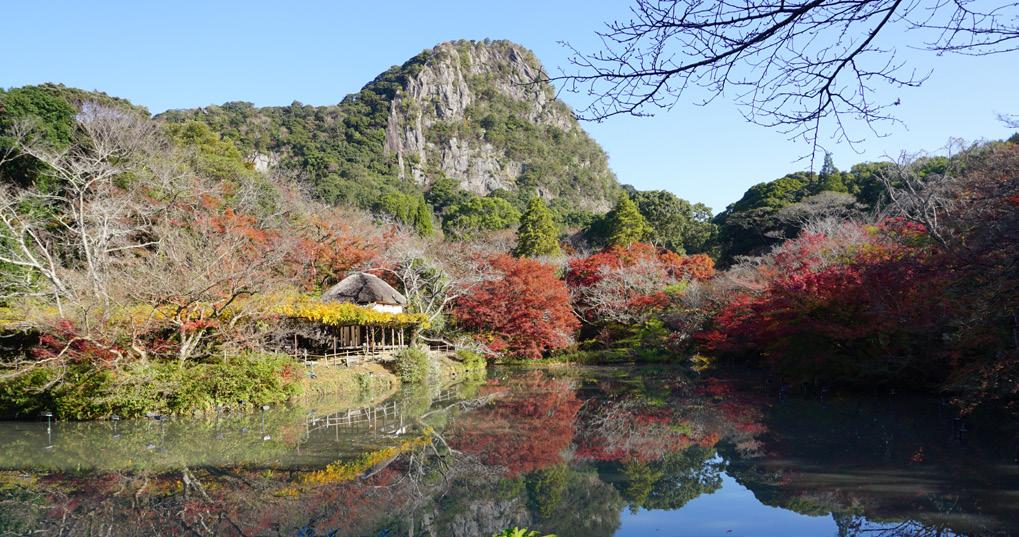 Image credit: Mark Christensen (Fukuoka)
Image credit: Mark Christensen (Fukuoka)
Near the border of Saga and Sasebo City, we encounter the famous Huis Ten Bosch Theme Park (16). Seemingly out of place and time, this Dutch-style theme park contains one of Japan’s largest illumination displays. It’s especially famous for its seasonal events, including a large-scale Christmas festival and its beautiful spring tulip displays.
If we drove about an hour to the north from Huis Ten Bosch, we would pass through the crowded city of Sasebo and pass into some remote countryside. Marked with a small park, this is the place to visit for those who wish to see the westernmost point in mainland Japan.
With an eye to the area’s history, however, let’s head south to Shimabara Peninsula. Here, the land is rich in local tradition and geology.
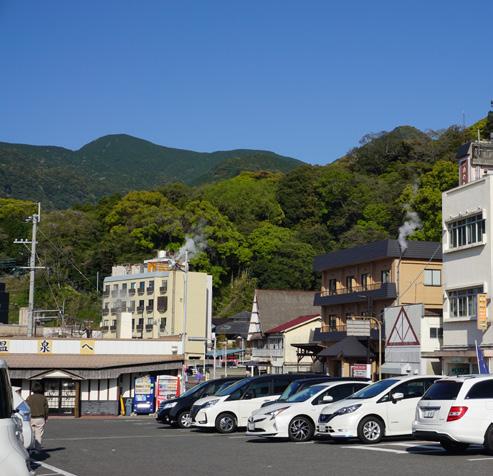

The city of Shimabara (17) itself is based at the foot of the towering Mount Unzen (18). Hundreds of years ago, the city’s castle was a focal point of the Shimabara Rebellion. While much of the original castle was dismantled, the reconstructed keep serves as a museum to showcase the secret history of the Kakure Kirishitans (“Hidden Christians”) and legendary heroes like Amakusa Shiro, while the outer grounds honor Seibo Kitamura, a key figure in the design of Nagasaki’s Peace Park.
Mount Unzen itself is also readily accessible for drivers. Unzen Ropeway, which provides a gondola ride to upper areas of the mountain, is only a 40 minute drive from Shimbara. Depending on the season, the ride provides excellent views of white, rime-covered trees or brilliant pink azaleas, and once you’ve been lifted up the hill, you’ll also find the trailhead for a short, scenic hike to the edge of the newest volcanic craters.
A few kilometers’ drive from the ropeway, you can also enjoy the Unzen Jigoku area, famed for its many natural hot springs. My favorite local hot spring area, however, is the seaside onsen of nearby Obama (19), where we will rest our weary feet for a while, as we plan our journey back to the east.
Join me next time as we conclude our travels across Kyushu’s four remaining prefectures: Kumamoto, Oita, Miyazaki, and Kagoshima.
Mark Christensen is a fifth-year ALT from Snohomish, Washington in the United States. An avid photographer, he has a passion for mountaineering and capturing the beauty of Japan. He currently resides in Omuta, Fukuoka. You can follow his photography on his Instagram
Image credit: Mark Christensen (Fukuoka)

As an animal lover, coming home to an empty apartment that didn’t allow pets was a bit of an adjustment. You don’t hear tippy-tapping on the floor getting louder and louder the moment you get home, you don’t get a hairball nuzzling your leg. Nothing. Living alone is not my cup of tea. And it wasn’t like in the Philippines, where I could just step outside and befriend a street cat or a stray dog; Japanese local governments are better at managing citizens’ safety than that, but at what cost? The crows and the falcons were not easy to befriend either. I needed an animal to care about soon or I would go crazy.
So I did what any sane person would do: swipe right on every Tinder profile with a photo of a pet and hope we matched so I could come over and pet their fur babies. Unfortunately, I don’t think I appeal to Japanese women, so that didn’t work at all. So I did the next best thing and looked for an animal shelter on Google Maps. I honestly just went to the closest one as soon as my free time matched up with their opening hours. I headed for Mauruuru, which was, thankfully, a short bike ride from my apartment. (And very close to Taniyama Station for anyone interested in supporting our cat café!)


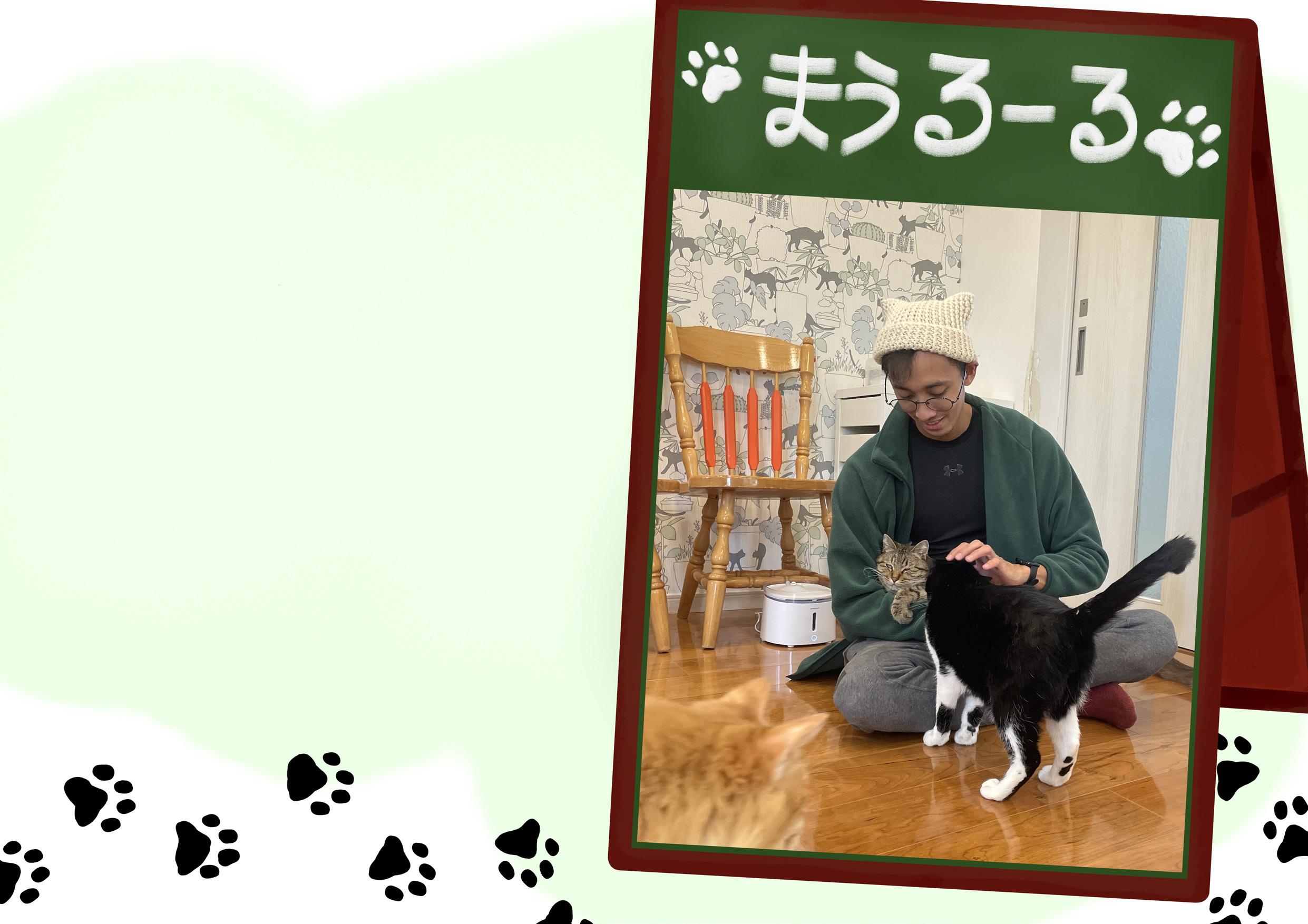





had no plan! I had enough Japanese to get me through konbini transactions and I could say Hai whenever I didn’t understand something. I thought of pretending to be interested in adopting, even though I knew my apartment wouldn’t allow it. (But honestly, I had already started looking for pet-friendly apartments and would move once my current contract came to an end.)
When I got there, I met Kazuyo-san, a very accommodating Japanese lady who spoke very little English.
I spoke toddler-level Japanese and we just managed to understand each other thanks to a charades-esque conversation and inaccurate translations from Google Translate.
Nevertheless, she was very happy to hear that I wanted to volunteer and help out at the café-shelter on weekends when I was free. They did not have enough hands to pet all 25 cats and four dogs.
he started with what I think was low-key an interview to check if I was a sociopath. She asked my name, where I was from, where I worked, and when I arrived in Japan. I answered in Japanese when my ability would allow it. I think it’s safe to say I passed the test. Next, she invited me into the cat café to see if the cats liked my vibe. Fortunate-ly, I think I smelled friendly to the cats, and they very quickly became comfortable around me. Even Petty, the top-ranking boss of the 25 cats, seemed to approve of me.

After a short conversation, Kazuyo-san bid me adieu and said that she was looking forward to seeing me on Sunday.
was very excited, though I had no idea what I had gotten myself into, since I’d never volunteered at a shelter before, let alone in a foreign country. But, I had always been the type of person to jump right in and hope for the best, and it had worked out for me so far. When I got there on Sunday, Kazuyo-san gave me a warm welcome and introduced me to her niece, Emi-san, who was a groomer at the shelter. They often tag-teamed to communicate with me whenever one of them felt like their English had run out. They were both very friendly and introduced me to almost all the cats in the shelter. There were too many names for me to take in and I could only remember the quirkiest and cutest ones. To this day, I still don’t know all of the cats’ names, but that doesn’t stop them from being very cuddly.
fter all the introductions, my first task was to hold the food bowl for Santa-san, a cat they had rescued who suffers from balance issues due to problems with his ears. Funnily enough, I arrived wearing a Santa hat so they thought it was very fitting for my first interaction to be with him. They said my hat was very cute and I replied jokingly, “Thank you, it’s my only hat and my head gets cold when I bike.” They laughed, and Kazuyo-san disappeared for a bit, only to return with a beanie that forms cat ears when it’s worn. I held back my tears as best as I could and asked if they were sure. I was very happy with my Santa hat but I love getting gifts! She insisted, and to this day I wear the beanie every time I bike. “This woman is too kind,” I thought. I didn’t know the half of it. . .

got to know the second-floor cats that day. The first-floor cats, the café cats, were the pretty and friendly ones who, for the most part, loved people. They still had varying personalities which made the café very interesting for visitors, who had their own preferences. She said it’s like that so some people come back to try and win the approval of Boss Petty or the extremely shy black cat. This was a genius business strategy. There was a rotation so that some of the second-floor cats could come down to the first floor now and then, as long as they didn’t have any illnesses and weren’t aggressive towards the café cats. Just so they could get to experience “employee” life. To be fair, the employee life was pretty good. The café cats were paid in food to get petted all day. What a life!
he second-floor cats held a special place in my heart though. A lot of them were abuse victims or had certain disabilities which made it hard for them to get adopted. Some had broken or missing legs, digestion problems, or other disabilities. Kuu-chan, a gray cat missing an eye, was my welcoming committee and instantly ran up to me and proceeded to lick my neck. The moment I found out he was the designated food finisher, I knew we would get along. But he was a bit of a challenge when feeding the other cats—you had to be mindful and keep him from sneaking in and taking a bite!

azuyo-san used to work at a pet hospital, so she takes in the cats treated at the hospital that don’t have any owners, as well as cats she and her husband find injured on the roadside. The new cats are still a bit hostile and afraid of people, but I find it amazing that some of the cats who have been there a bit longer are very genki (energetic) and friendly towards humans, and it's all thanks to her. Honestly, she might be a fae or a saint or something, she’s even friends with some local crows and falcons who come by to say hello and circle around her now and then. I definitely found myself a mentor in terms of kindness to animals.
he next few times I volunteered, she was more comfortable with giving me more tiring tasks, which I was happy to take on! I really wanted to help out in a way that would make their lives easier. So far, she had asked me to wipe and disinfect the walls, help set up our event sales, and give the genki dogs a walk, which I would describe as more of a sprint. She s aid they were happy that I was tall and that she would take full advantage of it. She also lets me bring “guest stars.” I try to invite friends from a variety of different countries to visit the shelter, since she’s very interested in hearing about different cultures. She sends us home with treats each time we visit, even though we’re happy just to be there. Kazuyo-san is extremely generous and, since I can never turn down any sweets, I always come home with a full stomach and a full heart.
definitely intend to continue volunteering at Mauruuru for many weekends to come, and it’s something I look forward to at the end of my week. It has become an avenue for me to practice my Japanese conversation skills and helps me feel like I’m truly part of my small town. I’m glad I went out on a limb and asked nicely if I could help out, because the experience has made my life here much more homey and has helped me decide to stay longer. I encourage all ALTs to look for something in your local community that you’re interested in, and just ask if you can be part of it! I believe the universe runs on the “ask and you shall receive” system—you just have to know how to ask properly. Go for it! It never hurts to try.


Christopher is a first-year ALT from Kagoshima. He majored in psychology and worked as a Montessori teacher in the Philippines before coming to Japan. He spends his free time gaming, playing sports, and learning how to cook, and is a regular volunteer at まうるーる in Taniyama. He hopes to stay in Japan for another four years.
CONNECT is amagazine for the community in Japan, by the community in Japan. Everyone is welcome to write, no matter your experience or style! If you have an idea you want to see in these pages, reach out to our Head Editor, or any of our awesome section editors. We’ll work with you to make it the best it can be and share it with our audience of thousands. Not every article needs to be an essay! We feature interviews, infographics, top-ten lists, recipes, photo spreads, travelogues,andmore
Contact the Head Editor of CONNECT, Dianne Yett, at connect.ajet.editor@gmail.com with your submissions, comments,and questions.
Writeaboutsomethingyou’re doing.Writeaboutsomething youlove.Tellusastory.
Tellusaboutsomeoneinyour communitywho’sdoing somethingneatandnoteworthy. Cooks,collectors,calligraphers— wewanttohearaboutthe inspiringpeoplearoundyou.
If you’re an aspiring photographer and want your work published, please get in contact with the head designer, Kristen Ton, at connect.ajet.headdesigner@ gmail.com.
Letusknowwhatyouthink. InteractwithusonFacebook, Twitter,andissuu.com.
Have an article you want to share? Join our Contributors Page on Facebook to stay connected with our team so you can share your adventures whenever story strikes!
Interested in contributing to CONNECT? Want to stay up-to-date on interview opportunities, photo requests, and CONNECT announcements? Get involved with CONNECT by contacting our current CONNECT staff and reading about the possible positions here.
You can also like us on Facebook, follow us on Instagram, and interact with the magazine via CLIP at ISSUU.